Daily Adventures
Day 26 – The end of the Road
Walking around Melbourne for the day concluded this month long journey that we have been sharing. It has been a wonderful trip. We saw so many beautiful landscapes, met interesting people from all over the world, and participated in fun activities. If asked about a favorite, it is really hard to pick just one experience. But there are highlights that stand out as we look back. Heli-hiking on the Franz-Josef glacier comes to mind and petting Koala’s and Kangaroos was better than expected. We swung through the trees in the New Zealand rainforest and hiked to waterfalls in the Great Divide Mountains in Australia. We saw beautiful lakes, beaches and coastlines and enjoyed the iconic sites in the cities we stayed in. And of course we tasted wine everywhere we went!


Day 25 – Hiking the Grampians

Melbourne gained it’s prominence in the late 1800’s during the gold rush. The areas that we traveled through today were centers for gold mines and people came from all over to strike it rich, including China, California, and even Europe. At the time the Melbourne government looked to capitalize on the influx of miners by charging a tax for people to gain access to the mining areas. People would try to avoid going through Melbourne to avoid the tax, but it was treacherous landing in the coastal areas west of Melbourne. At some point a group of miners organized and protested against the Melbourne government. This group eventually was successful in getting the tax reduced. From this effort grew a movement for representation for worker’s rights in this area. Later in 1856, similar labor representative groups for the stonemasons were successful in fighting for and achieving the ‘8-8-8’ workers rule. This rule required employers to provide eight hours work, eight hours rest, and eight hour play or free time for its labor force.
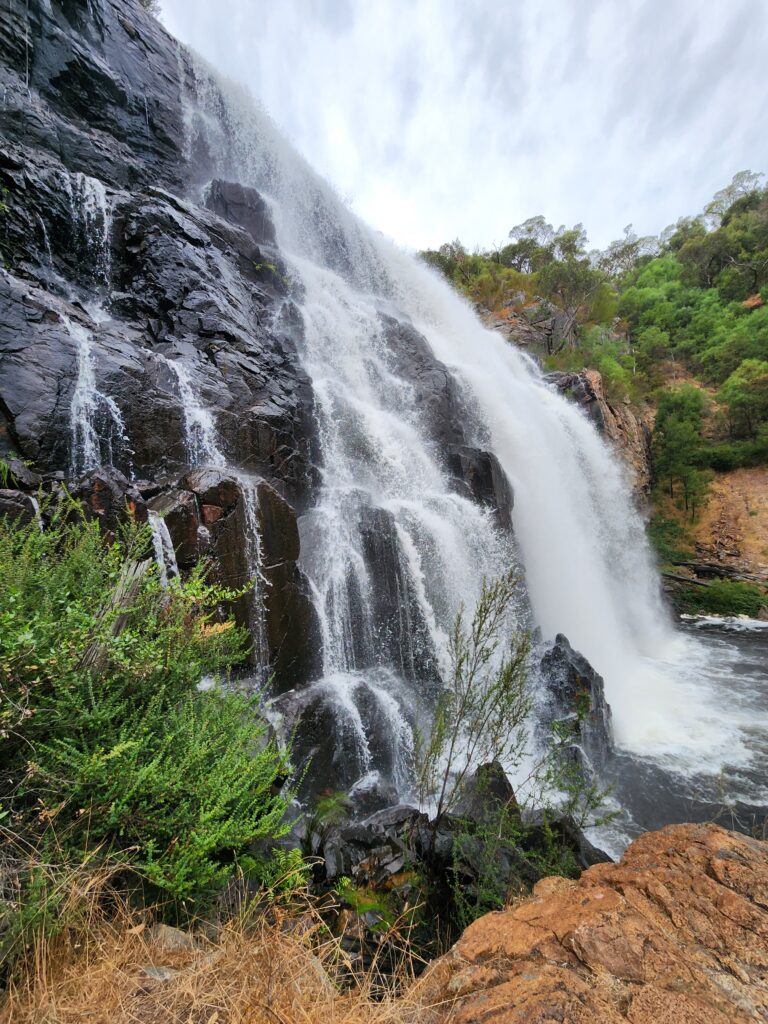

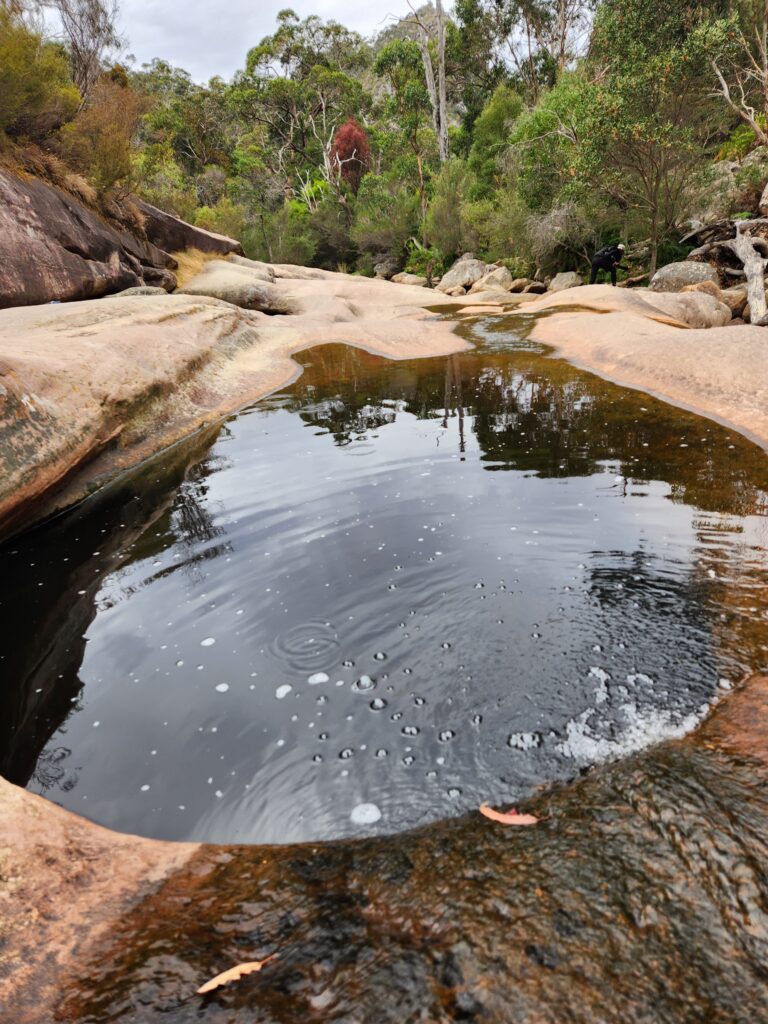
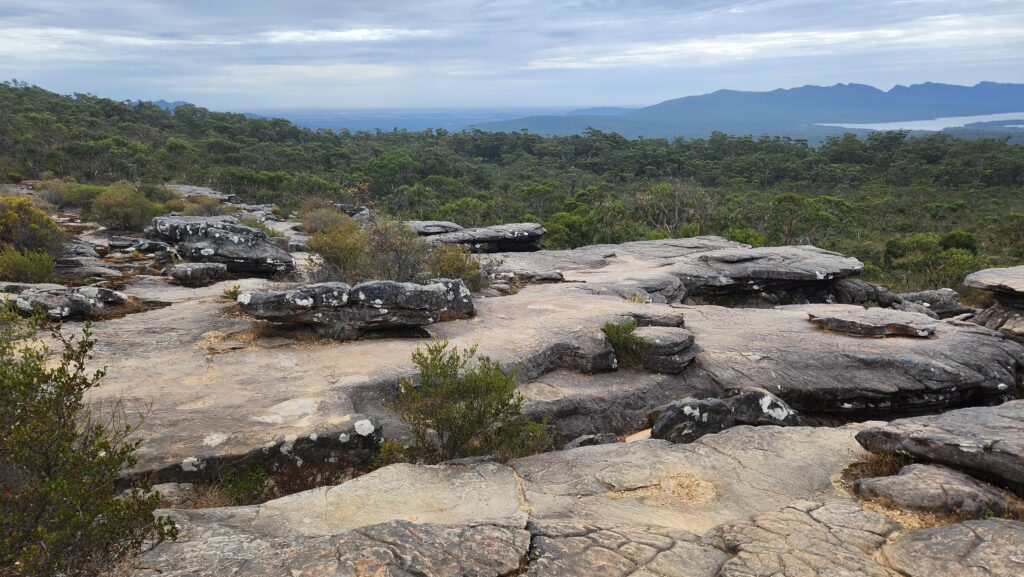
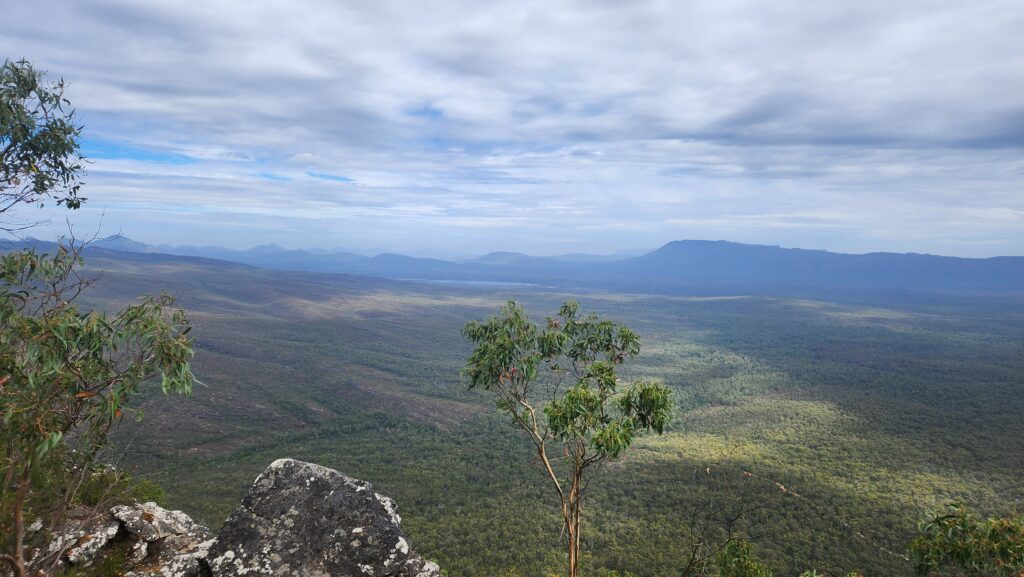

Day 24 – Yarra Valley Wine Tasting
We visited four wineries today in the Yarra Valley outside of Melbourne. The area we drove through was full of beautiful vineyards and farms with cattle and sheep. After the heat of the last couple of days, we welcomed the cloudy day that brought the temperatures down a bit. The wineries we visited were all small producers. One vineyard, Balgownie, was also a resort and spa with a great restaurant where we enjoyed lunch. Another vineyard also had a 15,000 seat music venue which recently hosted Matchbox 20. On the tour we enjoyed talking and drinking wine with several people in our group, one couple from Germany and another from Toronto as well as others. Overall it was a great, relaxing day.

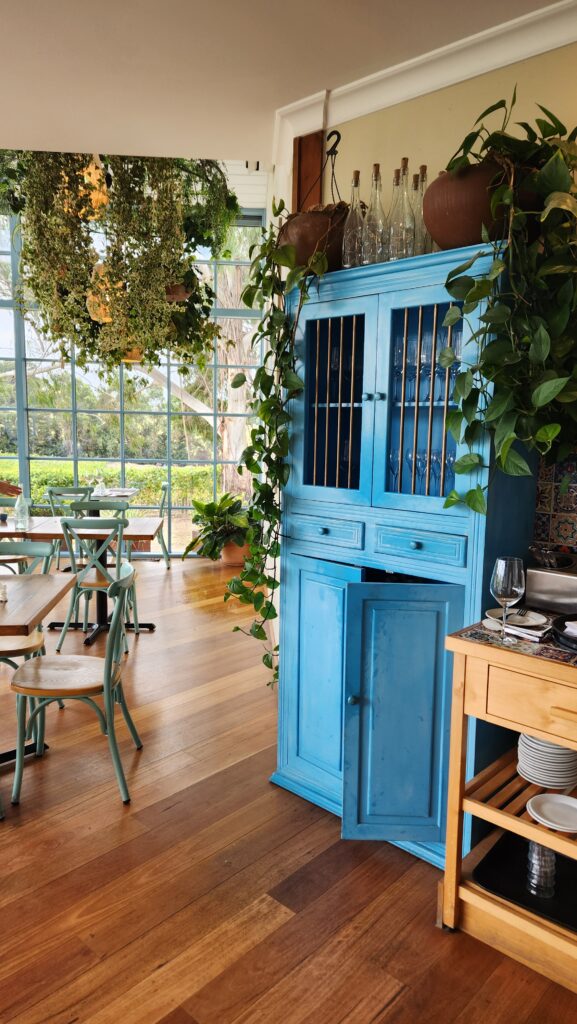

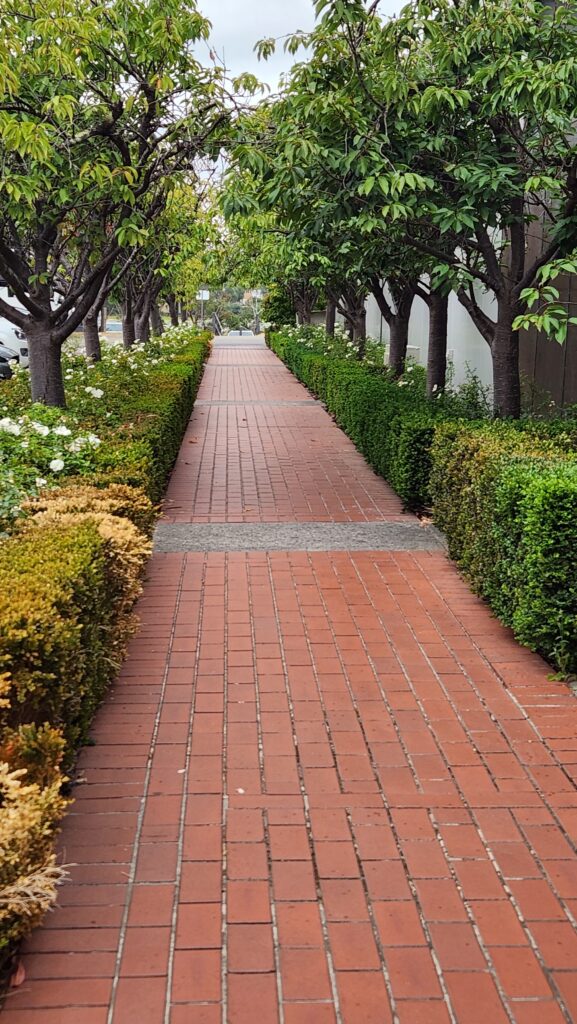

Day 23 – The Great Ocean Road

Off to an early start this morning with lots of ground to cover. The tour for today began at the eastern most part of The Great Ocean Road. Prior to WWI a consortium of local farmers saw the value of the ocean front property and thought it would be valuable to make it easier for tourists and others to reach the coastal areas. After WWI soldiers returning home were put to work creating the road as they transitioned from active duty back into life near Melbourne. Since then the constant wave activity became known in the surfing circles for good and consistent waves to surf. Today the Rip Curl Pro, Great Ocean Road surfing competition is held each year on Bells Beach. Along the way we stopped at a spot inland, Melba Gully, where there is a natural temperate rainforest. The cooler temperatures of the rainforest were much appreciated relief from the heat of the day. We ended the day, touring the 12 Apostles, which are made of combination of sandstone and limestone. This combination accounts for the difference in erosion that creates the stand alone apostles. BTW there are only 7 apostles standing today!

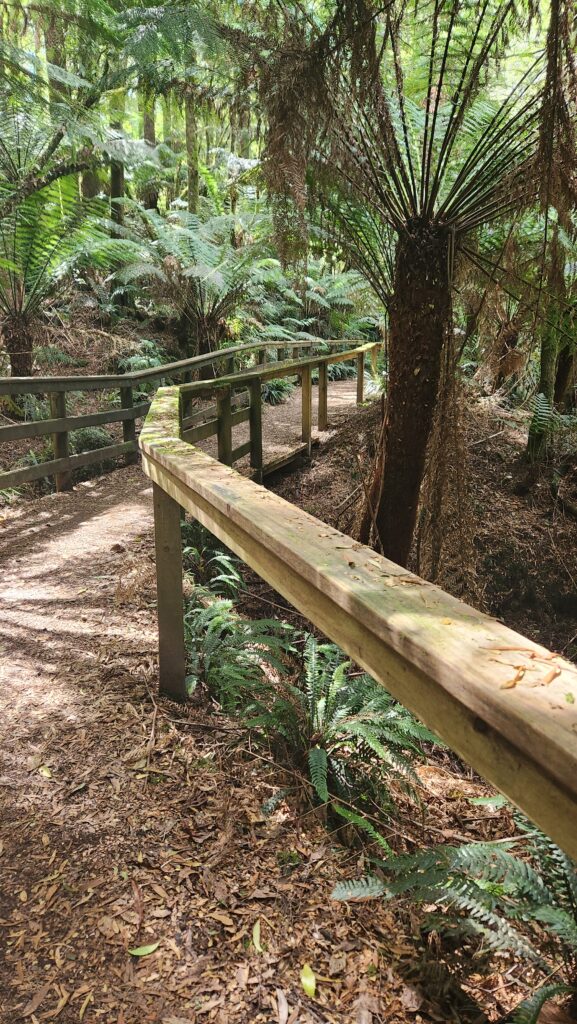
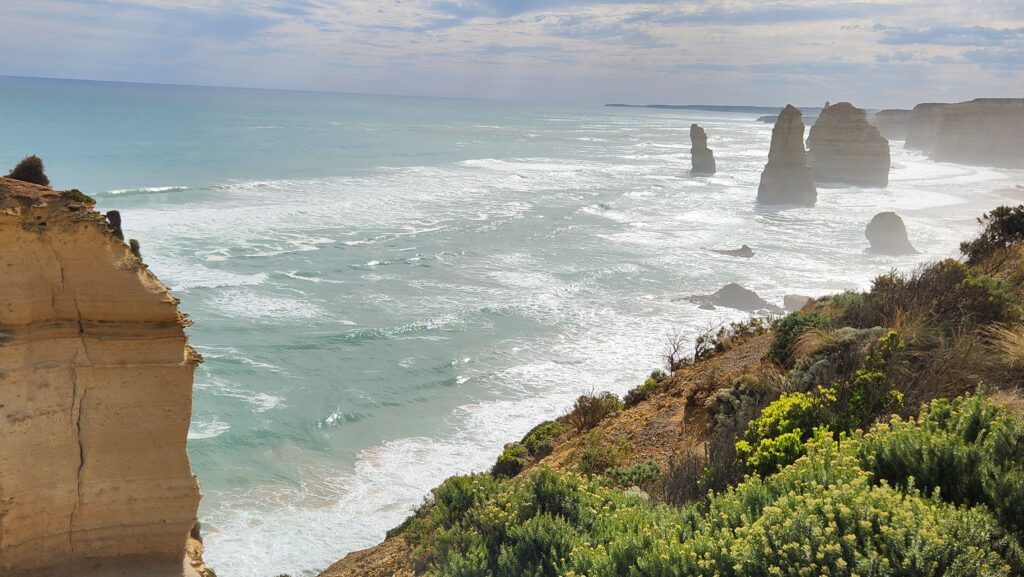


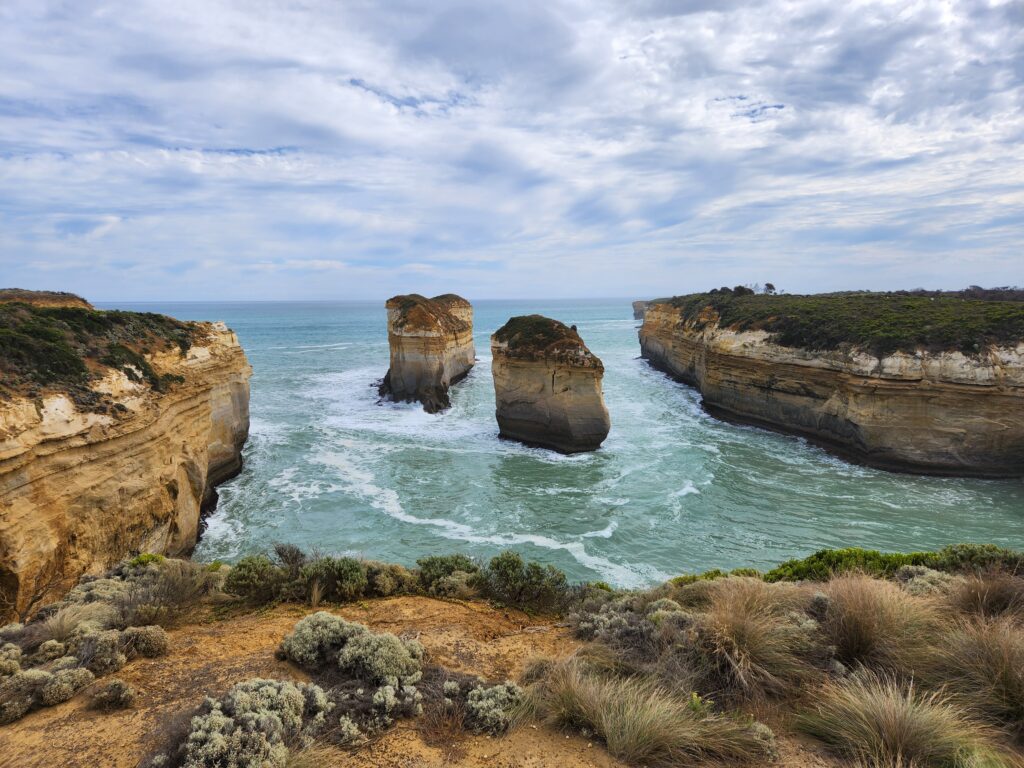
Day 22 – Melbourne Beach Day
Along the path between St. Kilda Beach and Elwood beach, we saw great views of the city skyline. After stopping for lunch at a cafe on the beach, we walked inland to Albert Park, a large green area in the city. At this park preparations were underway for the F1 Australian Grand Prix. The grandstands, fences, and tents were already up. Rod Laver Arena where the Australian open is held, is nearby in Melbourne Park. We walked for a couple of hours, but as the afternoon heat kicked in we called it a day!
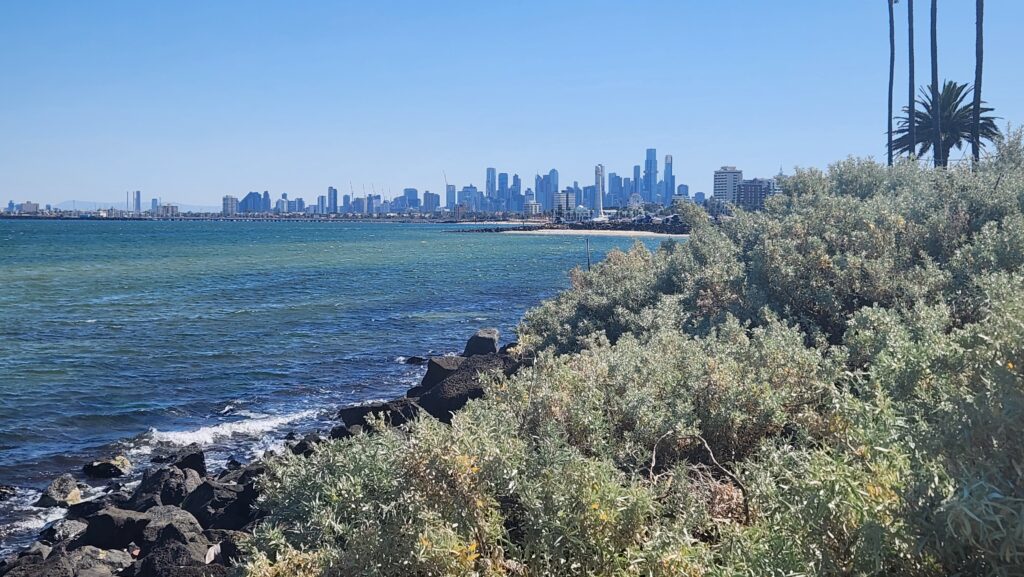
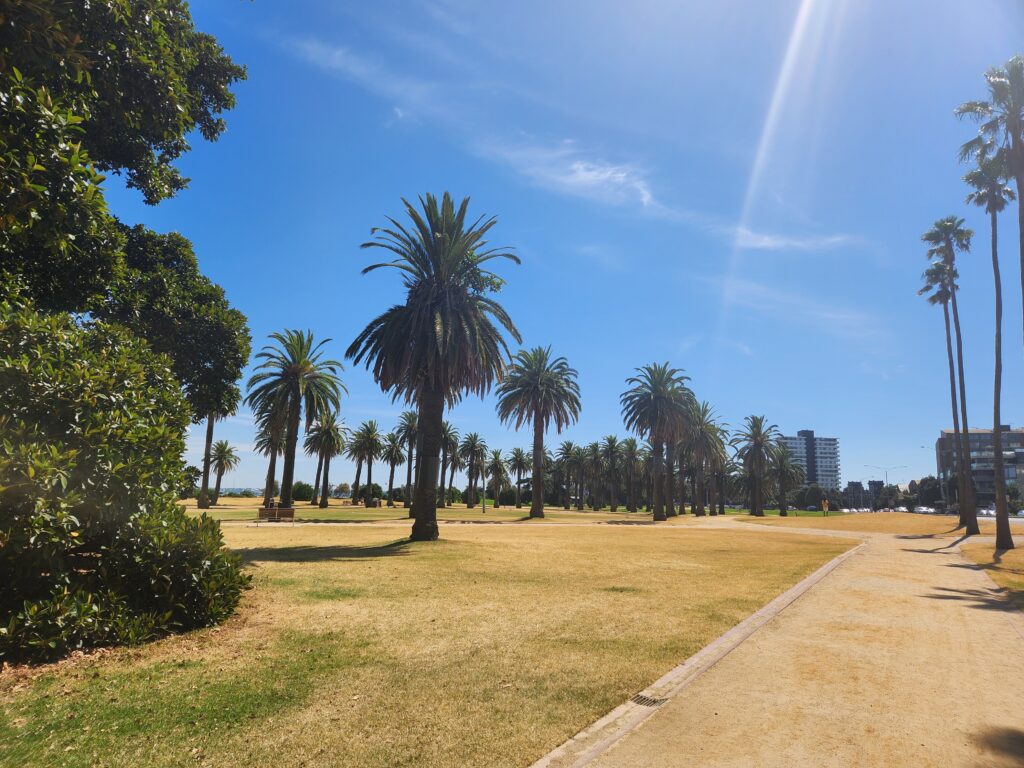

Day 21 – Sydney Rewind
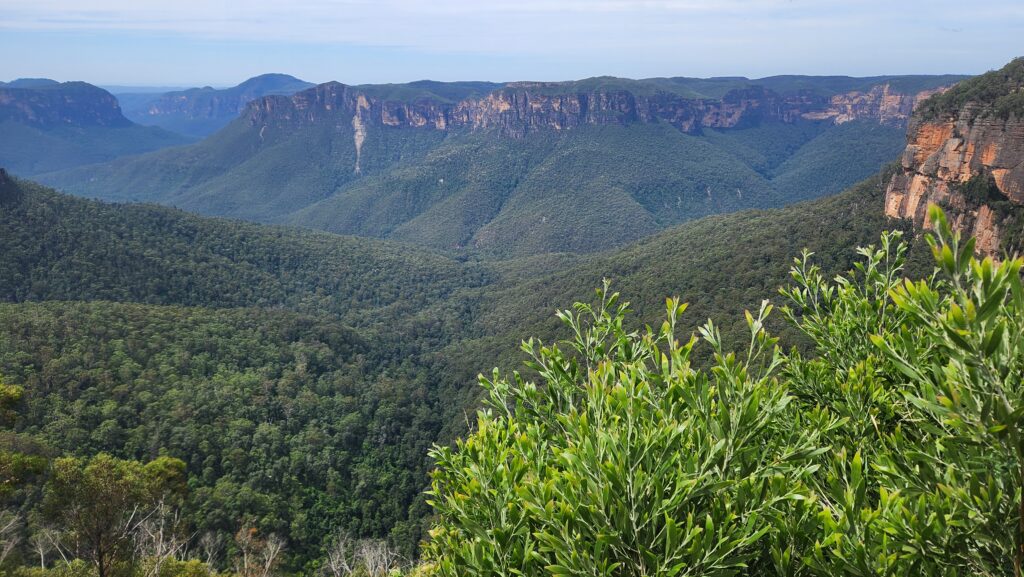
We leave Sydney today as we head to our last leg of the trip. Will the toothpaste last to the end? We don’t know! Stay tuned! Landed in Melbourne early this afternoon. Temps are unusually high here for this time of year, close to 100 degrees Fahrenheit. So tomorrow we will be hitting the beach! Sydney and the surrounding area was beautiful, but we look forward to our adventures in Melbourne! Here is a look back at some of our Sydney highlights!
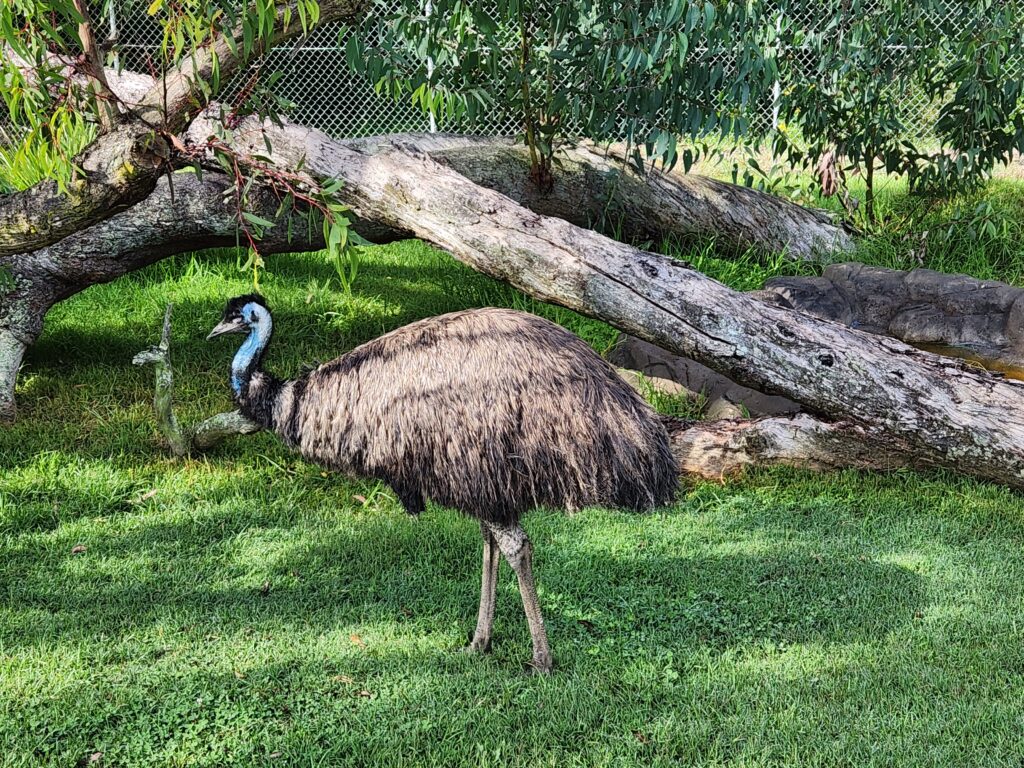
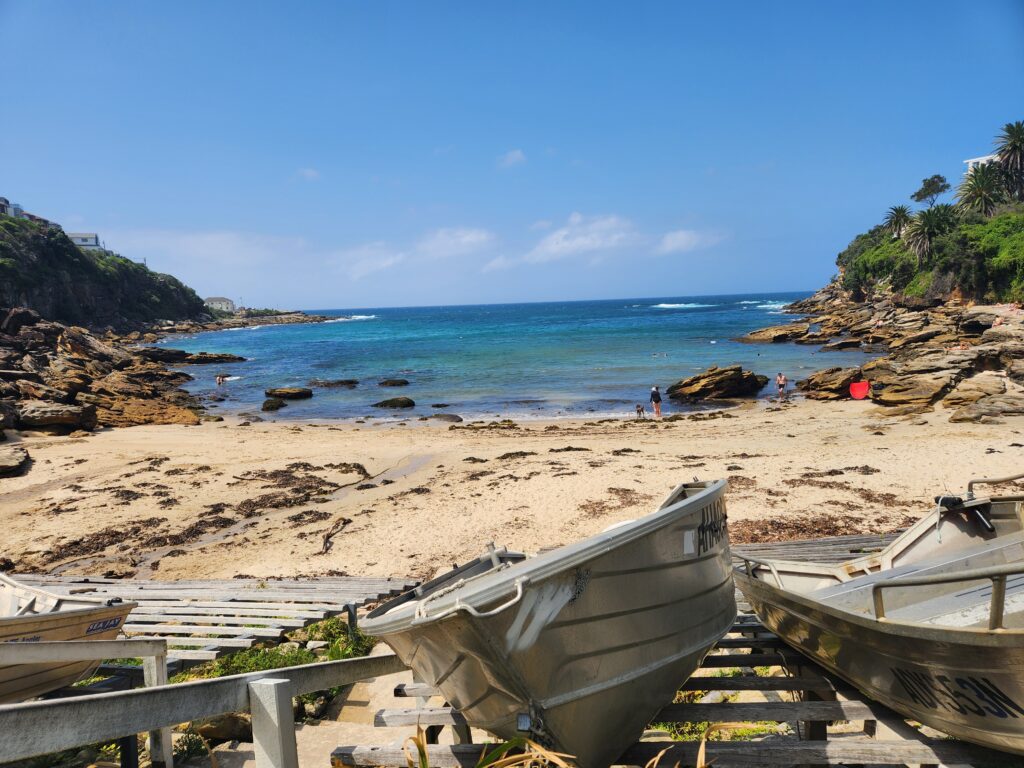
Day 20 – Wildlife and Waterfalls
Fitzroy Falls is in the Morton National Park that is part of the southern highlands region. The range of mountains is part of the Great Divide in Australia which include the Blue Mountains further north, but also ranges to the south of the Sydney area. Similar to the Blue Mountains, eucalyptus is a prevalent tree in this area. This area has not been impacted as much by the wildfires as previous forests we visited. Earlier in the day we stopped at the Symbio Wildlife Park where we were able to pet Koala Bears and Kangaroos. The park housed several of the indigenous animals to Australia; Koala, Kangaroos, Wallabies, Wombats, Emus, Tasmanian Devil, and Dingos as well as many bird and reptile species. After leaving the wildlife park, we stopped for lunch at Bulli Beach along the eastern coastline, south of Sydney. Getting to the beach required traveling along Sea Cliff bridge that has been built to replace a coastal highway due to its constant erosion and needs for repairs. The coast line is interspersed with rocky coast and sandy beaches. The sand on the beach we stopped at was sugar fine sand and the beach also had a salt water pool like the ones we saw by Bondi Beach. Tomorrow we say good-bye to Sydney and move on the Melbourne!

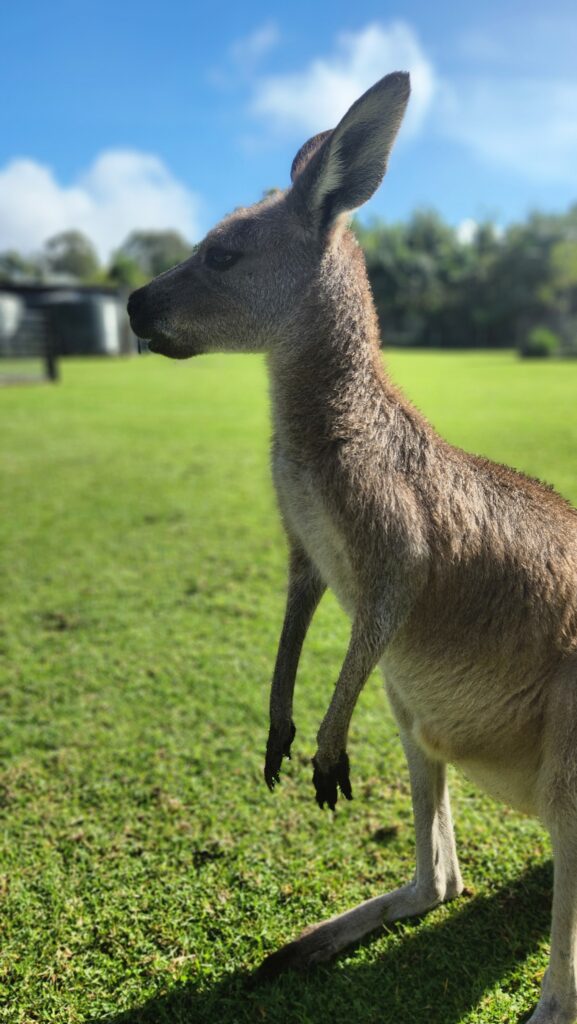

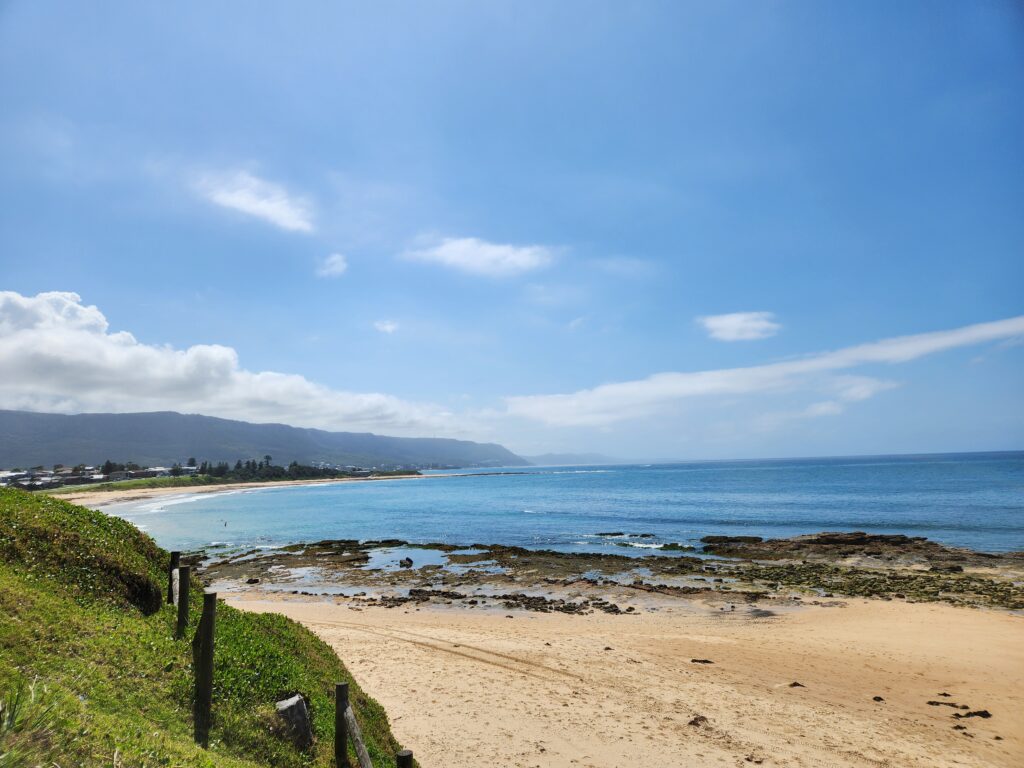



Day 19 – Beaches and Sunset
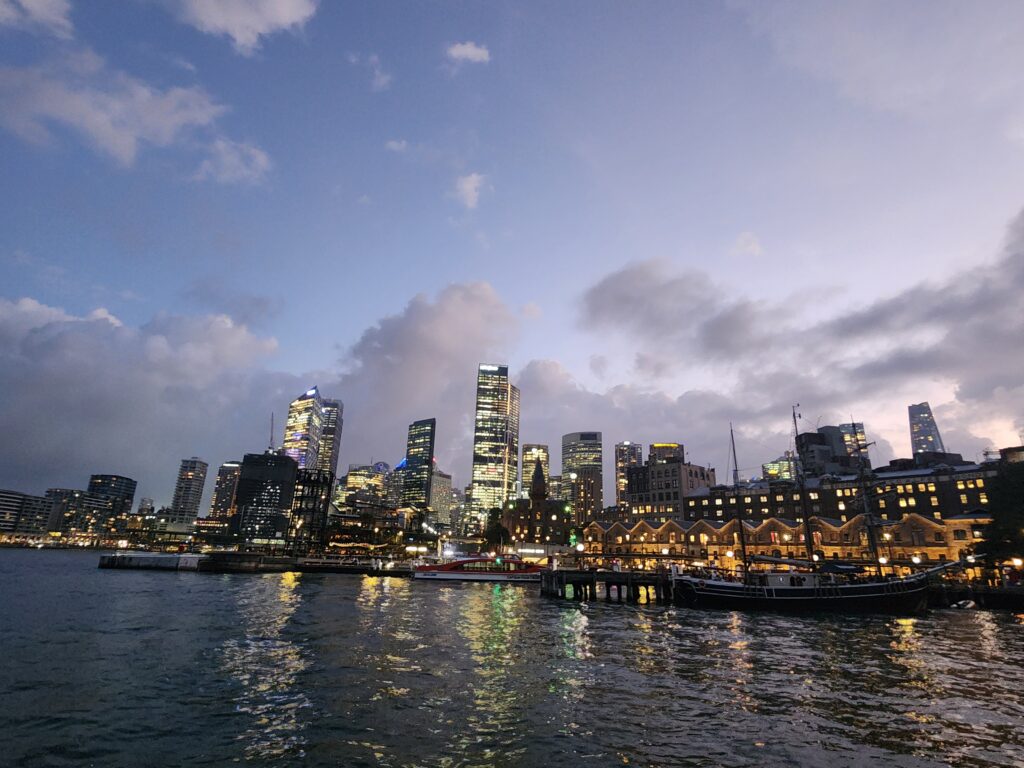
We walked along the coastal path between Bondi Beach and Coogee this morning. Bondi Beach is famous for its surfing and has been featured in tv and movies many times. As we walked along the coast, the path went up and down the rocky coast providing amazing views at each turn. Several places along the way, we went by areas where swimming pools or baths had been created. The surf is so strong that swimming directly off the beach is dangerous due to undertow, but swimming pools have been created to allow for safe swimming. We went by several beaches as the pathway wove in and out of the rocky coast. The day ended on a sunset cruise around Sydney Harbor. We left from King Street Wharf and were able to enjoy views of the Opera House and Skyline from the water this time. Sydney is a beautiful city, the harbor is a central feature of the city. It seems to cover so much space. As we were on the cruise we could see the ferries going from spot to spot on the harbor. Five days here just begins to scratch the surface!
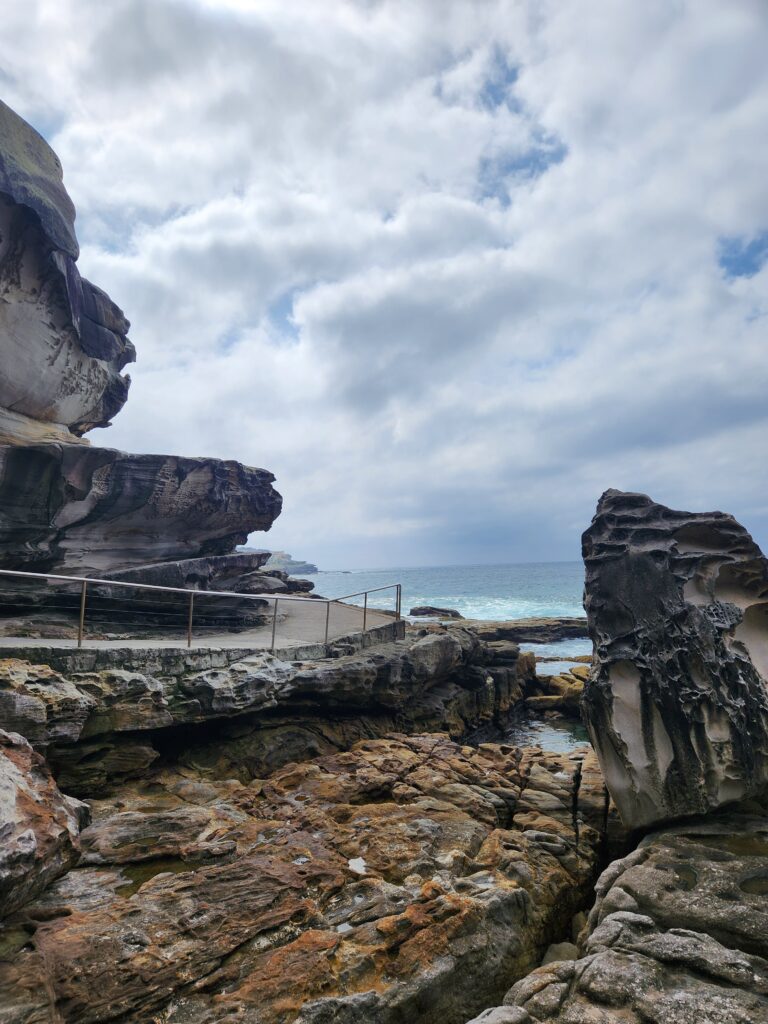

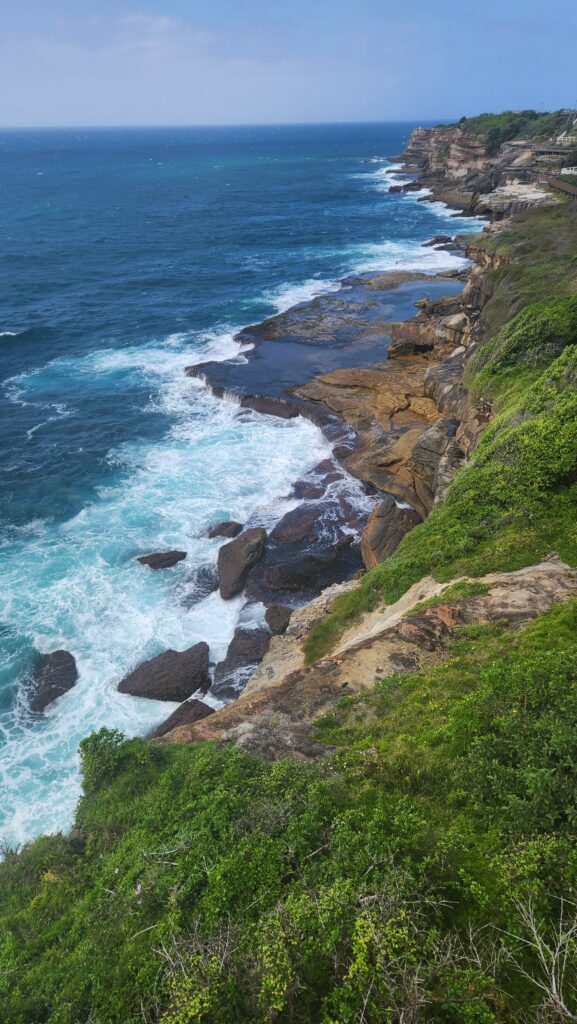
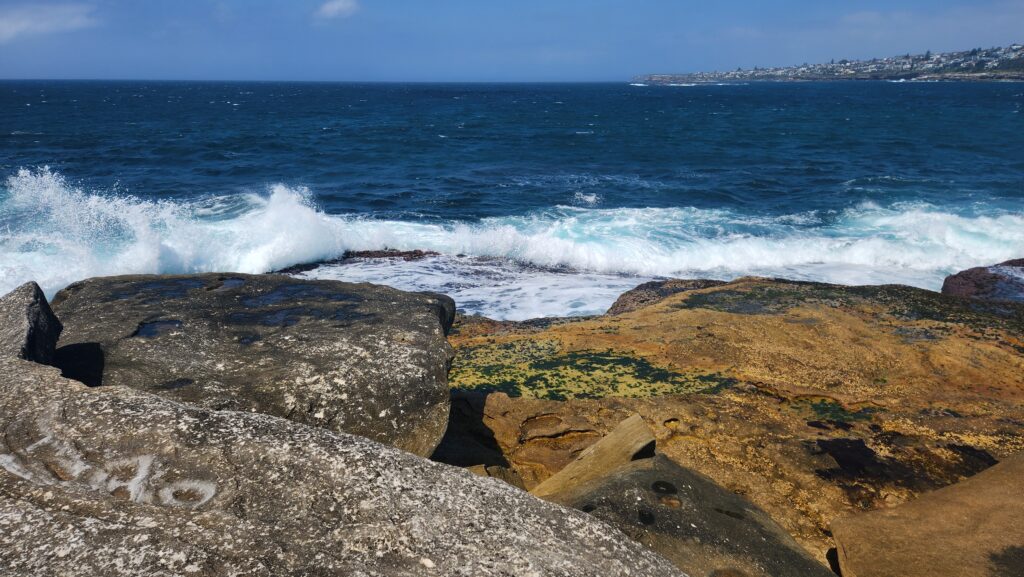
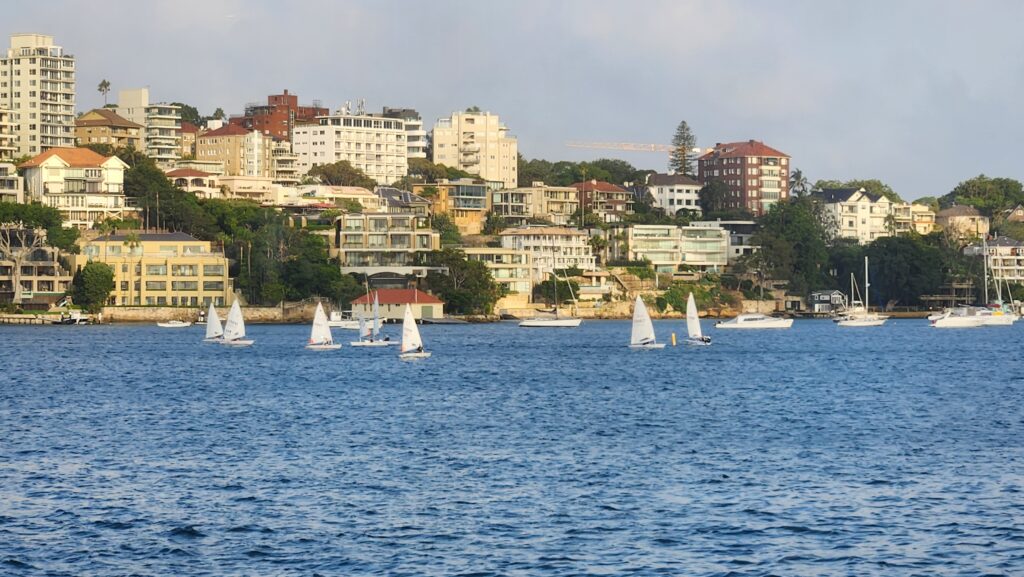
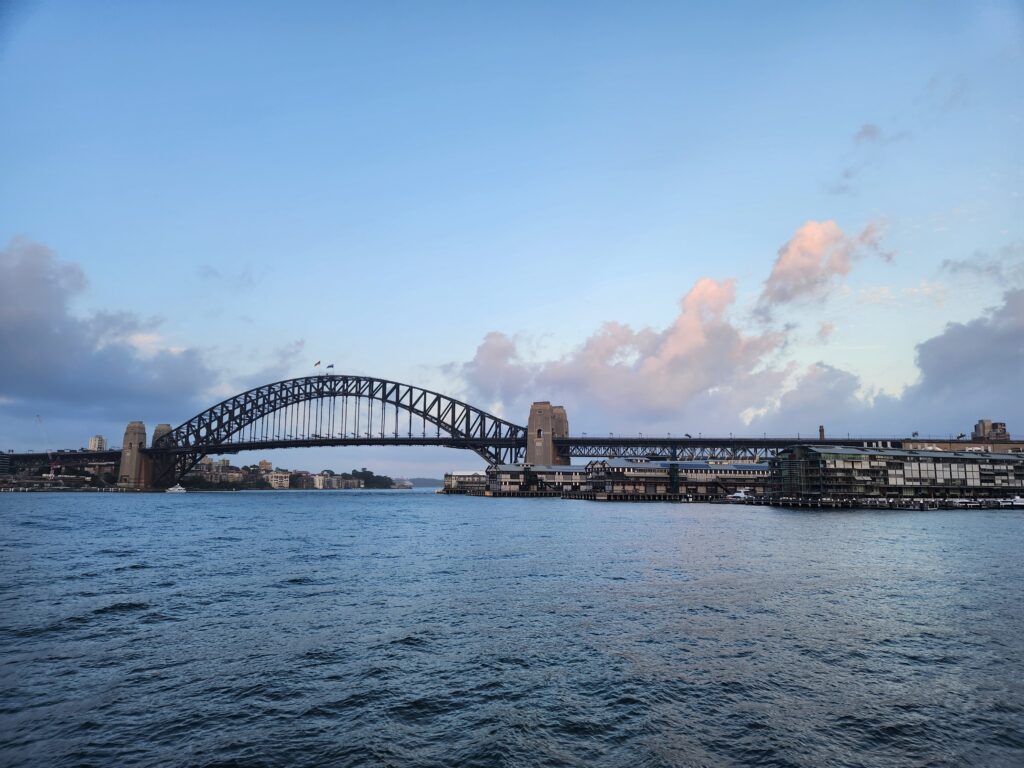
Day 18 – The Blue Mountains
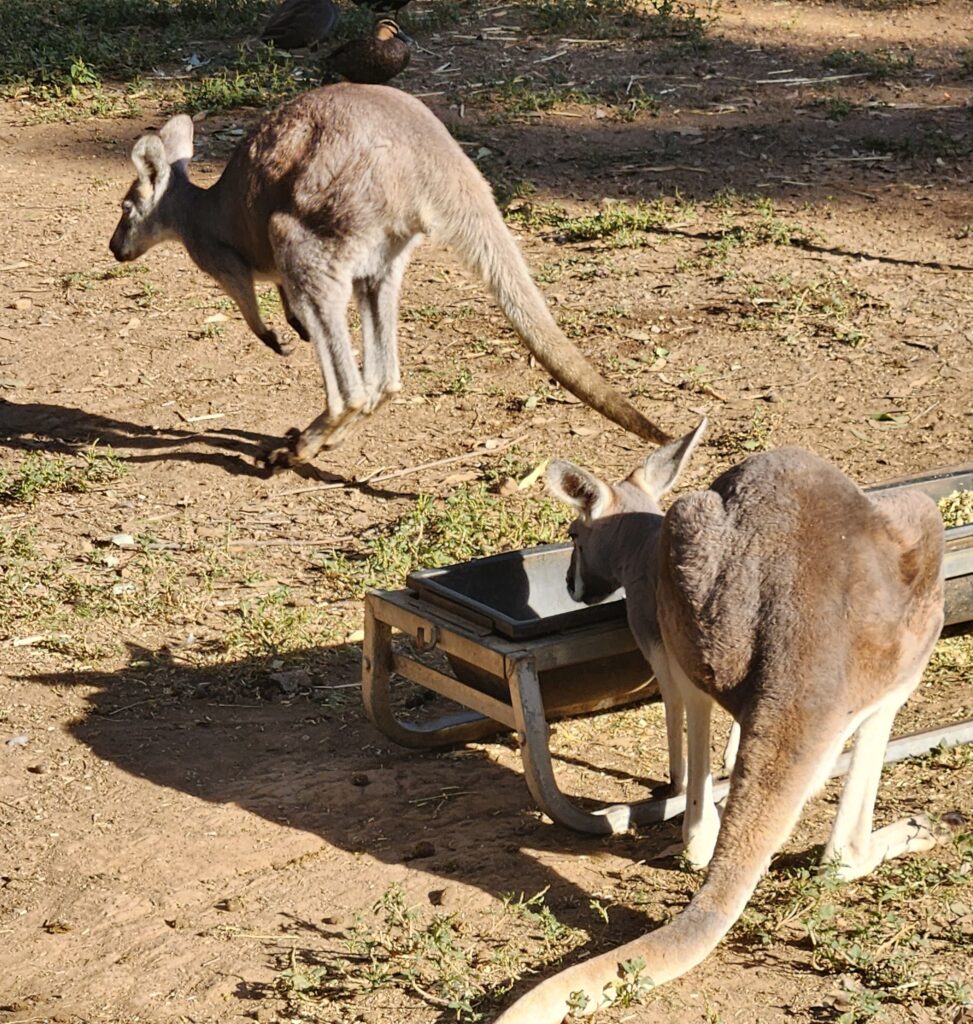
We started off the day meeting a kangaroo! (My goal of the trip!) Our first stop of this tour visited a farm that had kangaroos, wallabies, koalas, wombats, and emus. This was our chance to see wildlife, as much of the population was devastated in the Blue Mountain region by the recent wildfires in 2013 and 2019. While the vegetation has begun to return, the wildlife continues to struggle in the Blue Mountain area. Although kangaroos have done well in Australia at large, outnumbering humans 2 to 1. The tour made several stops at various scenic overlooks. The “blue” of the Blue Mountains is created by the oil bearing eucalyptus trees that evaporates in the heat of the day to create the blue haze over the mountains. One stop was a spot to view the Three Sisters rock formation. Legend tells that the Aboriginal witch doctor turned the 3 young maidens to pillars of stone when they desired to marry outside of the tribe. Other stops provided beautiful vistas of the red rocks of the region. The tour ended at the Mount Tomah botanic gardens overlooking a valley of the Blue Mountain park and displaying many fauna and flowers. One surprising inhabitant is the Wollemi tree. In 1994 this tree was determined to be a species that has been indigenous of Australia and New Zealand some 65 million years ago.
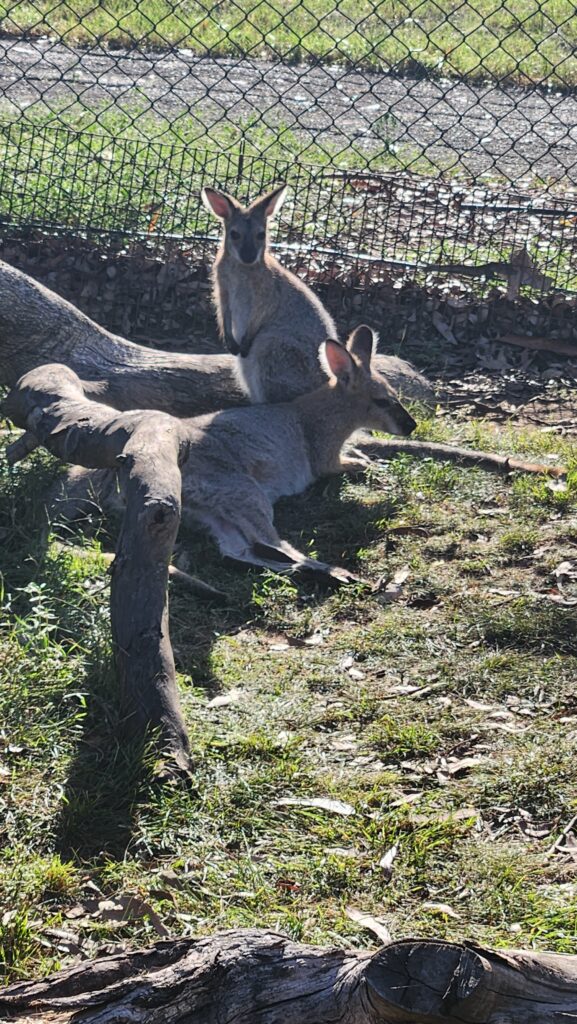
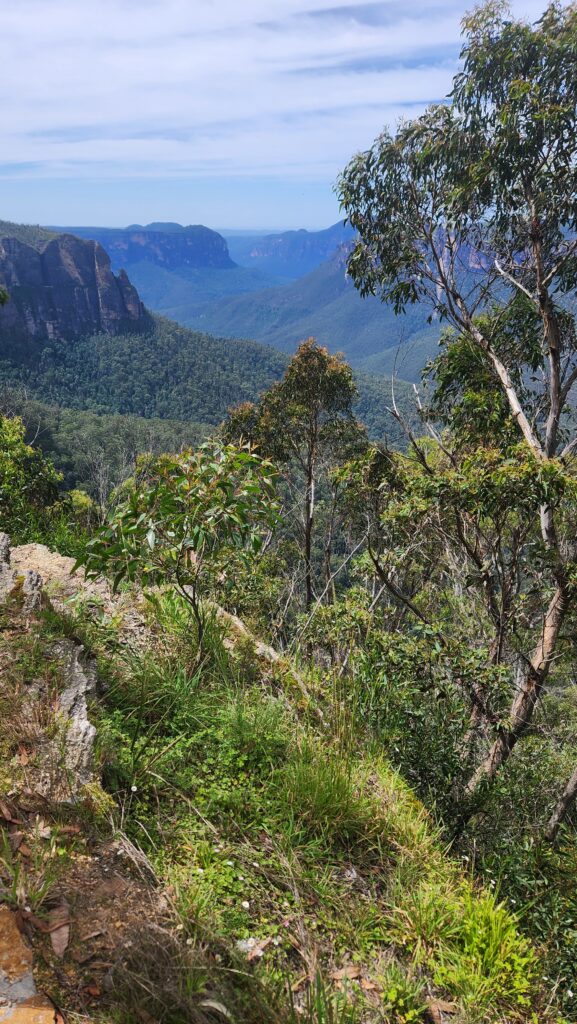
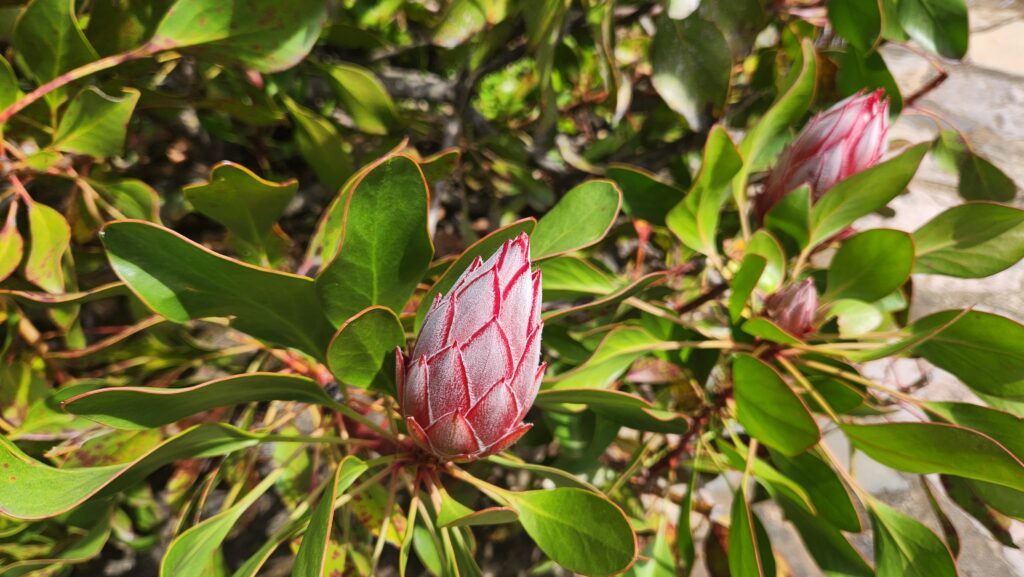
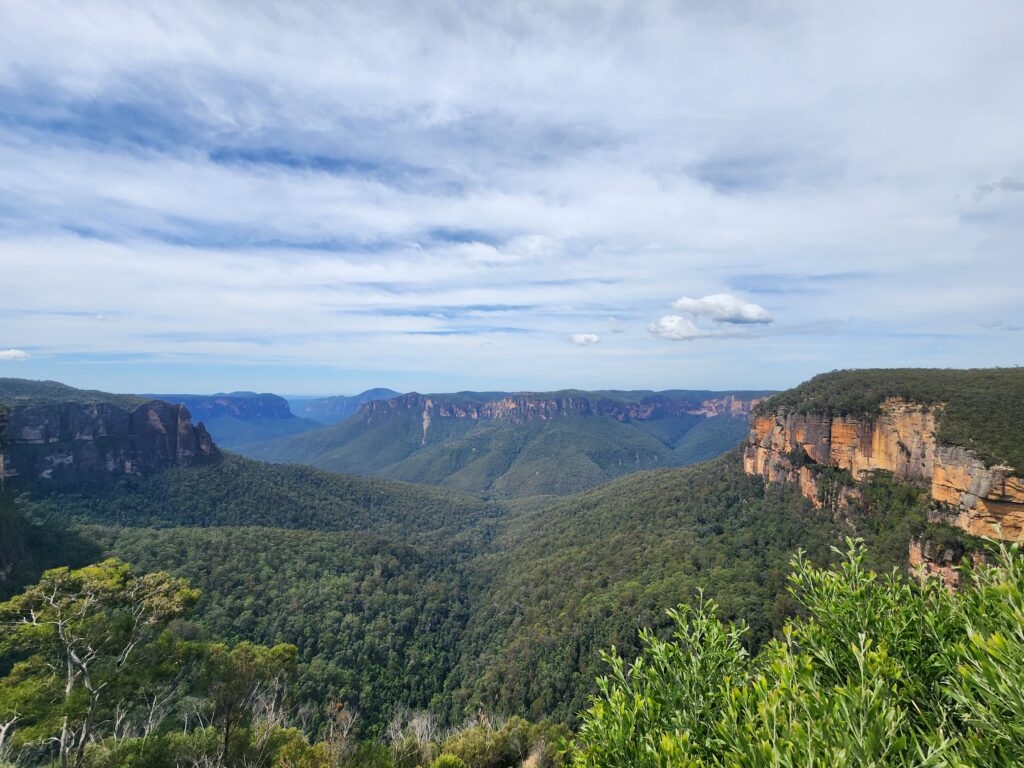

Day 17 – The Sydney Opera House
The tour of the Opera House provided many different and interesting details about the history, current uses, and structure of the opera house. On the tour we were able to enter the inside of the main concert hall, capacity roughly 2,700. The opera house was designed in the 1950’s, but the project was not completed until October of 1973. There was a rehearsal happening for the performance tonight so we were unable to take pictures, but the design was particularly interesting. Performances by the symphony are performed without amplification, so the design and materials in the hall play a role in the acoustics. The overall structure of the hall is designed to be like the inside of a person’s mouth or throat with the middle arching up, above. On the ceiling the acoustics are set to reflect the sound throughout the hall, with boxes protruding from the ceiling. The inside of the hall is designed of all wood. Soft, birch wood is used for the ceiling and seats. This wood absorbs sound waves. A hard wood is used for the walls and floors of the hall and they are intended to refract sound waves. The combination creates a great sound quality. Due to the design of the roof line outside, the inside area where the symphony sits is very tall, roughly 22 stories high. This structure prevents the artist that are performing from hearing their instruments in real time because of the time necessary for the sound to reflect back to them. For this reason, fabric panels have been used to redirect sound back to the artists so that they might hear exactly what they are performing. Recently the opera house completed renovations that brought the facility up to the latest technology standards, while maintaining the historical value of the site. The opera house if listed as one of the UNESCO world heritage sites. The space was originally commissioned to serve a diverse population and the site continues to provide programming for many different audiences.
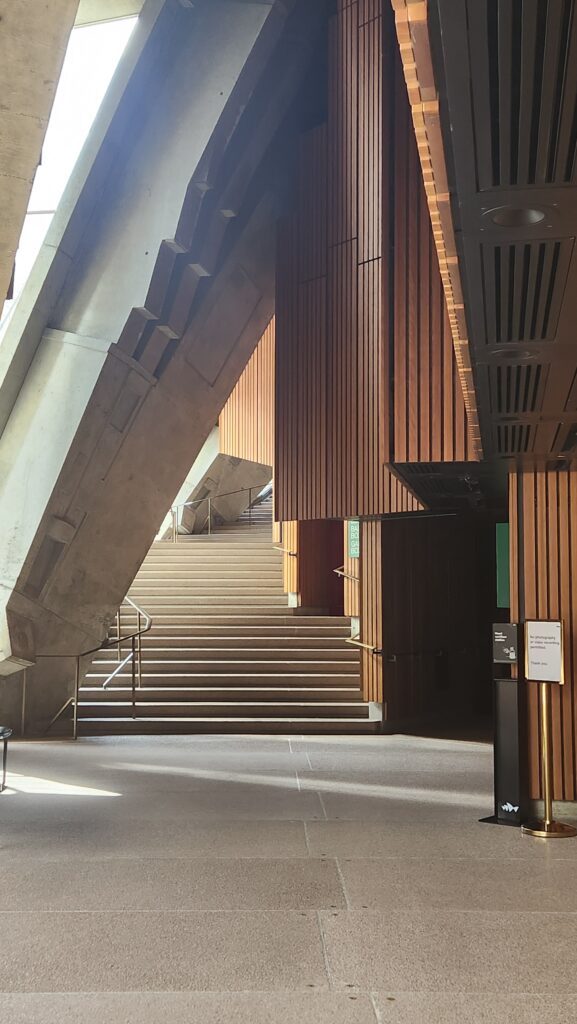
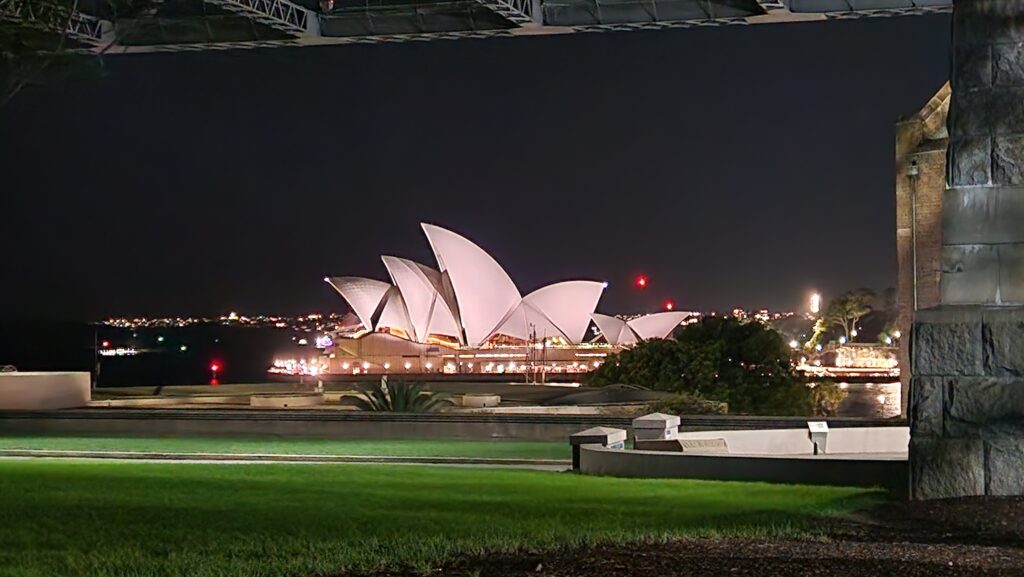
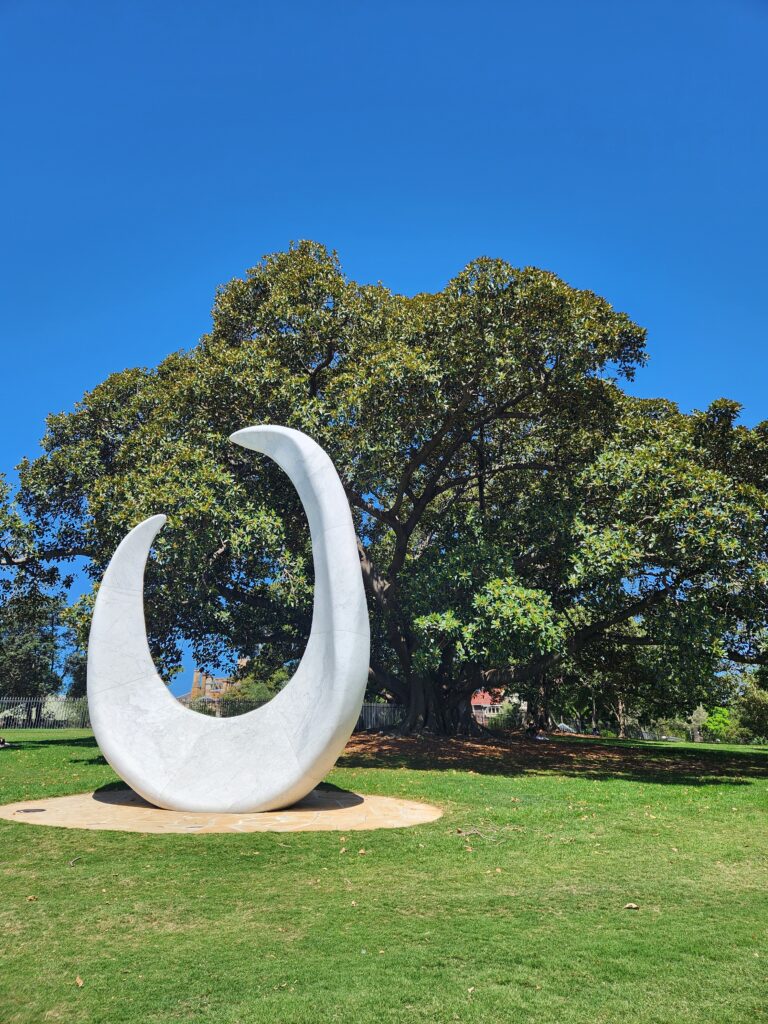
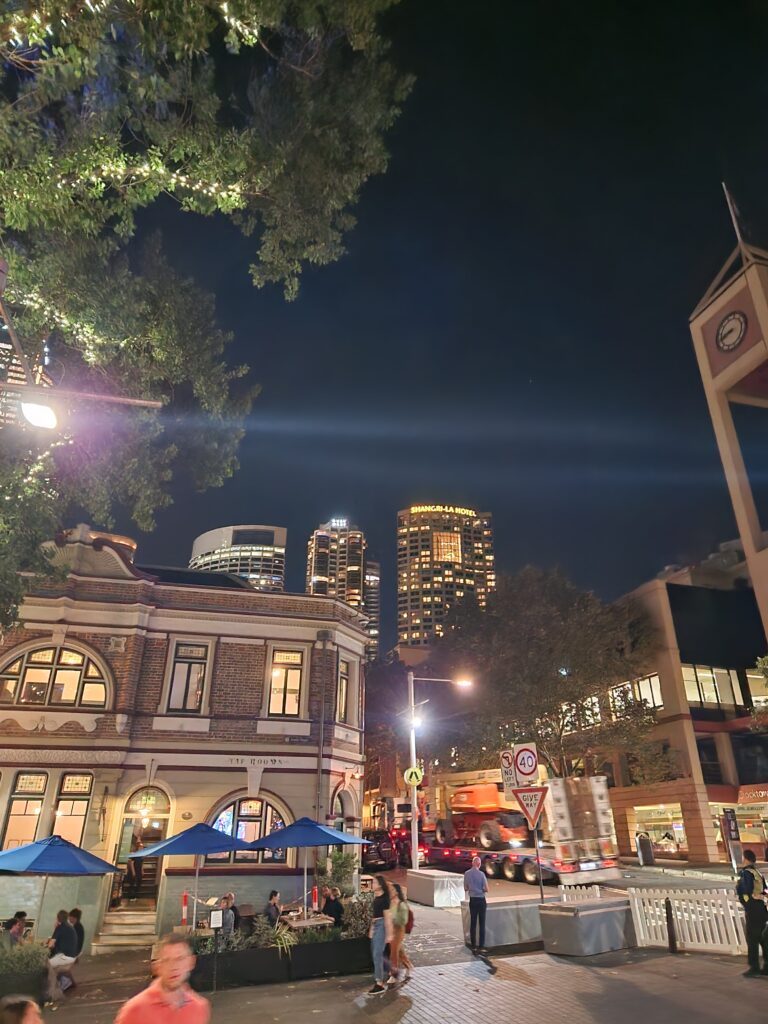

Day 16 – Country to Country

We took today as a recharge day, resting at the hotel which is located near Sydney Harbor. We found this yoga studio in the Bondi neighborhood and dropped in for a class which was good to get stretched. Tomorrow we will begin exploring the city in earnest.
Day 15 – South Island Recap
This morning we spent a little time walking around Lake Tekapo before driving back to Christchurch. Lake Tekapo is a dark sky region. Last night we enjoyed a clear sky and were able to see all the bright stars of southern hemisphere. Today as we explored we came upon the The Church of the Good Shepherd. A church built as a memorial to the pioneers of the region. It is a cute church set in a beautiful setting with the surrounding mountains during the day and brilliant skies at night. Tomorrow we make our way to Sydney leaving from Christchurch early in the morning. Please enjoy a brief recap of our time on the south island with a few pictures from each day.


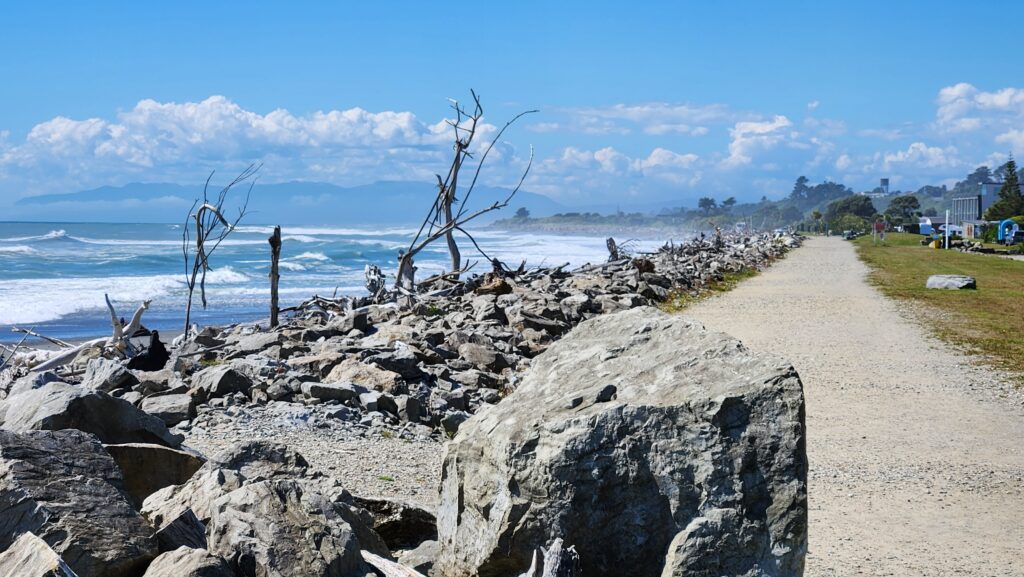

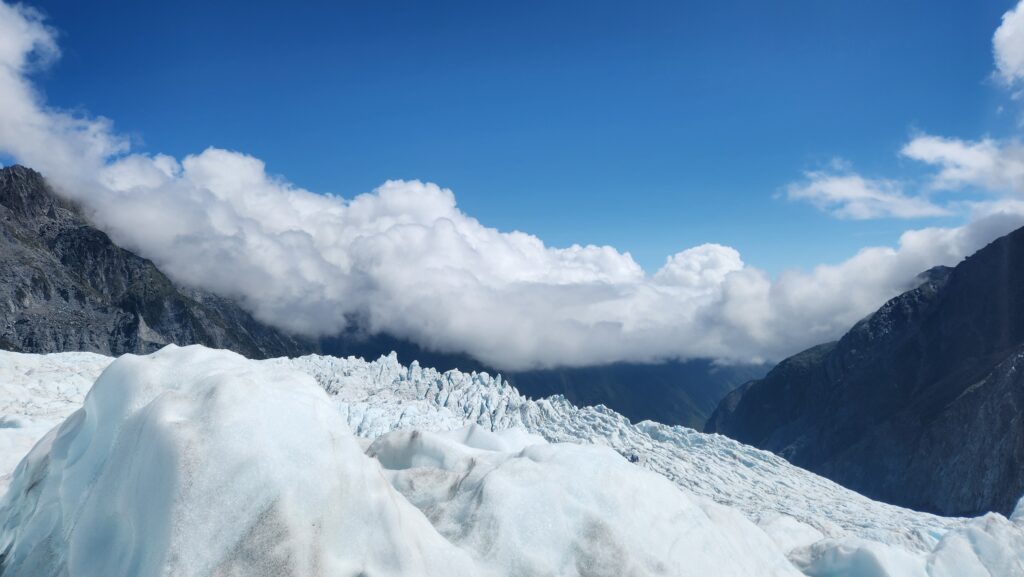

Day 14 – Hiking Mount Cook – Aoraki

Great hike today in the Mount Cook / Aoraki National Park on the Hooker Lake Trail. The trail traversed three different suspension bridges over streams coming from Hooker Lake. The water from this lake comes from the melting of the glaciers and was a milky white. The weather while we hiked went from rains and clouds to sunshine at times, lots of wind and gusts that almost blew us off the path. We felt as though we were on a quest for a ring (hahahaha!) Some of the pictures came out like a movie set!

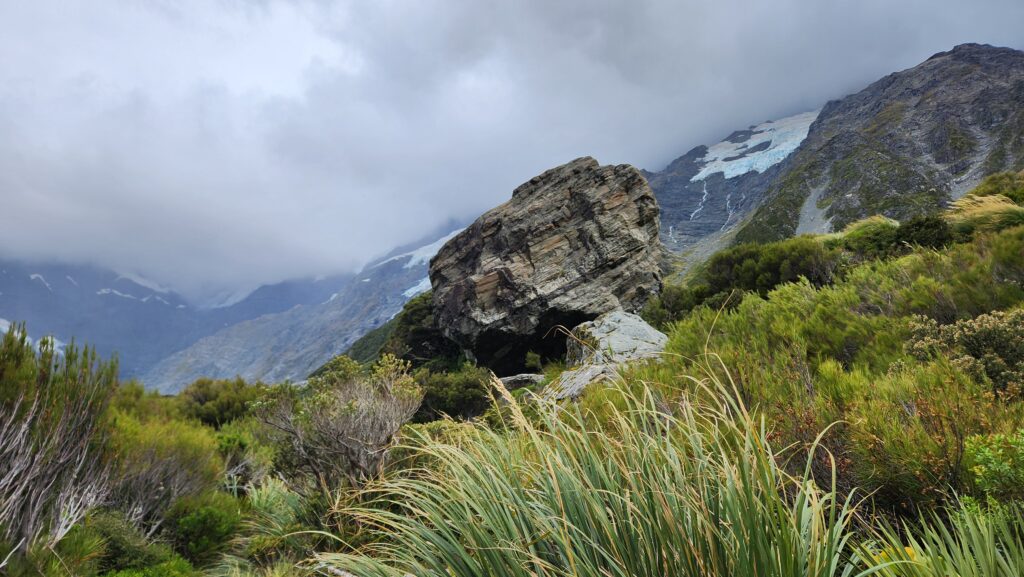


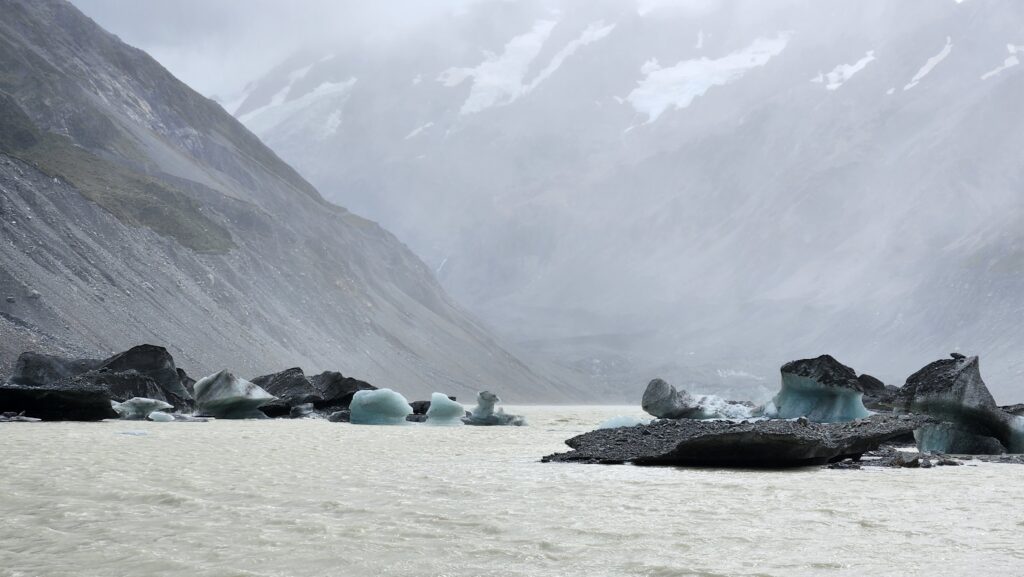
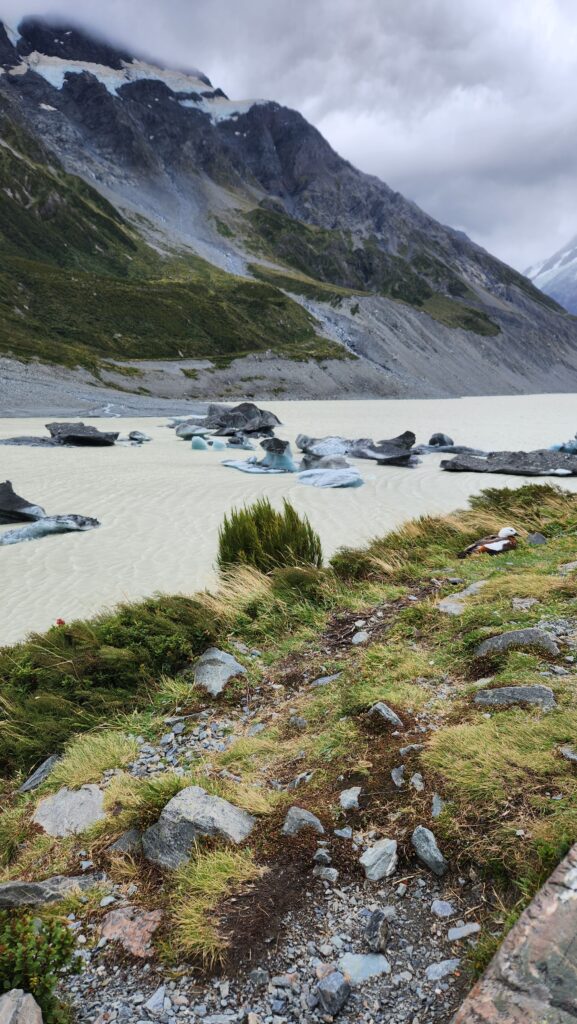
Day 13 – Lake to Lake
Today we awoke to a gorgeous sunrise over Lake Hawea. This area is an out of the way lake town. Our accommodation was directly on the lake, allowing for cool breezes and sounds of the water all during the night. From here we set off for our next destination about 3 hours north. While driving we passed by Lake Wanaka, a vibrant and growing town. After driving through an arid valley very conducive to wine growing, we came across Lake Pukaki, which turns out to be the bluest lake in New Zealand. Apparently the fine particles off the glaciers remain in suspension in the waters of this lake creating the deep, turquoise blue color. With Mount Cook rising in the distance behind this lake, the views were very impressive even from the highway! Did I mention wine growing? We stopped along the way at a winery that we just happened upon. Great tasting wine!


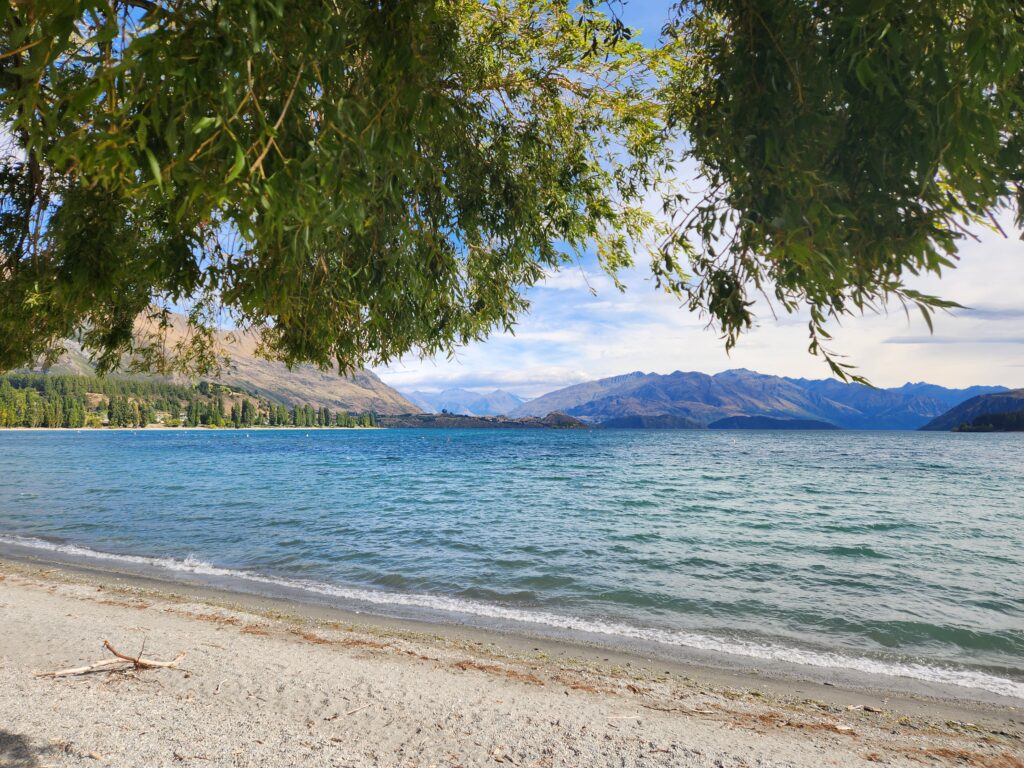

Day 12 – Franz Josef Glacier

The day started driving from beachside in Hokitika to the base of the Franz Josef Glacier. There were questions about the weather as to being able to helicopter to the glacier, but by 11:00 am we were on our way. We flew in the helicopter to a height of about 4,400 feet above sea level. From here we hiked around the glacier. The bulk of the glacier is at about 9,200 feet, well above where we were hiking around. On the hike we walked across ice, but also shimmied our way through narrow crevices, having to flatten ourselves like pancakes. While walking on the ice, there are rocks and dirt that have been churned from the bottom of the glacier. The Franz Josef glacier moves about seven meters per day. The ice is 200 meters thick and the bottom is typically melted, allowing the glacier to slide over the rock beneath. The water will then escape into crevices in the rock and freeze, breaking off bits of rock and dirt that eventually will churn to the top of the ice field. Once we were safely back on terra firma, we continued driving down the coast, turning inland at Haast Pass. Our sites where set on Lake Hawea where we are staying this evening. Along the way we passed through the “Southern Alps” as the mountains in this area are referred to, passing Mount Cook along the way. As we went from the coastal mountain side with very alpine terrain to the eastern side of the mountain pass, the look of the mountains turned to a more deserty look similar to Arizona or Nevada. Both large lakes that we passed, Lake Wanaka and Lake Hawea, have very turquoise blue water.
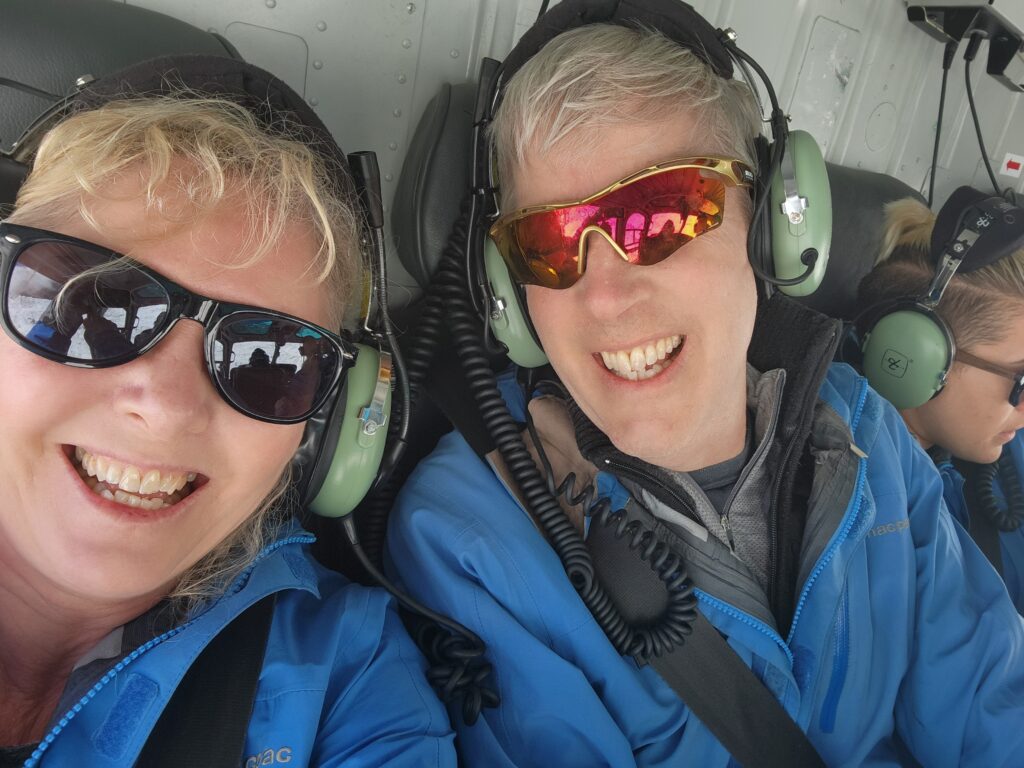
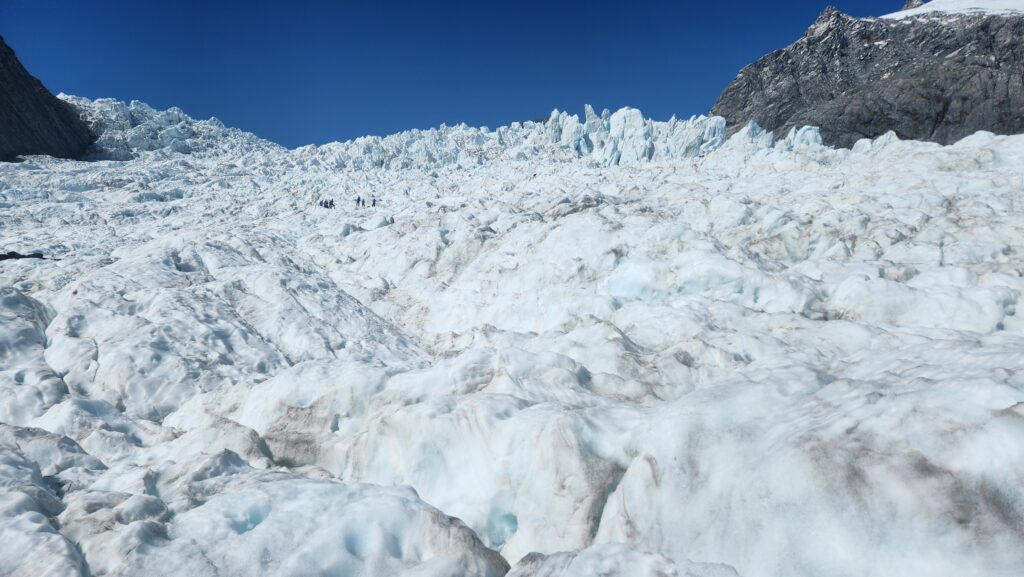
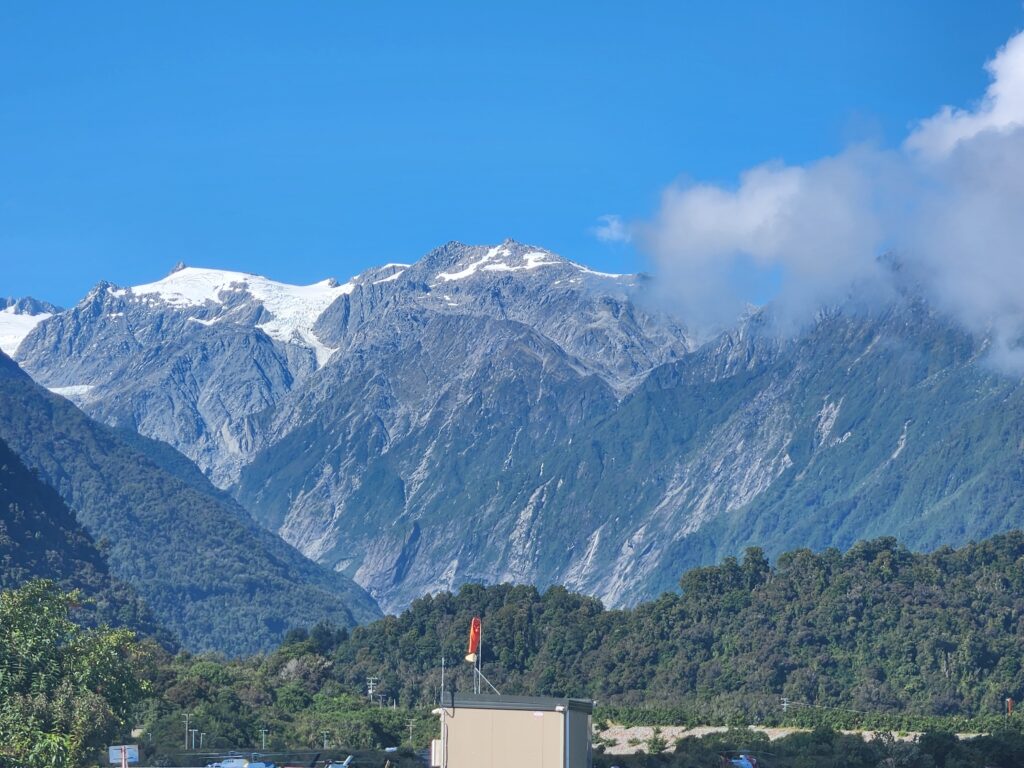
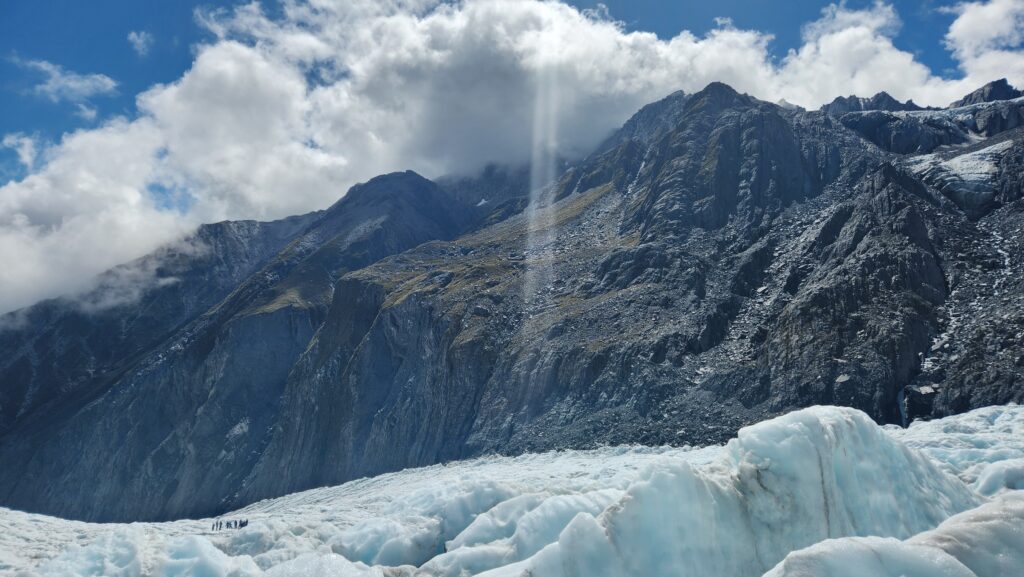
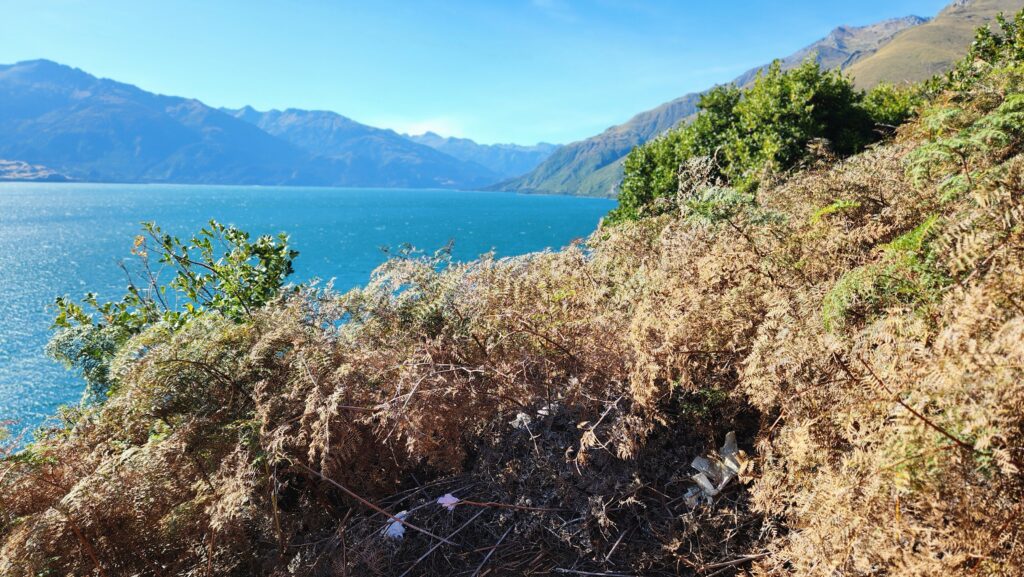

Day 11 – Coast to Coast
We boarded the train early this morning on a gray and cloudy day in Christchurch. The train ride included a scenic viewing area and nice breakfast and lunch served at our seats along the way while we enjoyed the views out the windows. The ride begins on the Canterbury Plains and passes through the mountains on the west side of the island. The train cuts through the narrowest part of the south island, stopping at Arthur’s Pass at 3,000 feet, a national park about halfway through the journey. The mountains on either side of the pass reach up to 6,000 feet. We ended the train ride in Greymouth a gateway town to the west coast. From there we rented a car (more left side driving, stay left, look right) to reach our hotel for the night in Hokitika. I was particularly excited for this destination because of a book I read in preparation for this trip. The book is called The Luminaries and it is set in Hokitika in the 1860’s during New Zealand’s gold rush. The book talks about the difficulty that ships of the day had in entering the port at Hokitika because of the shallow straits that exist offshore. Tonight we walked along that same shore and could see exactly what the book was depicting. Our evening ended watching the sunset on the Tasmanian Sea as we sipped an Otago Pinot Noir.

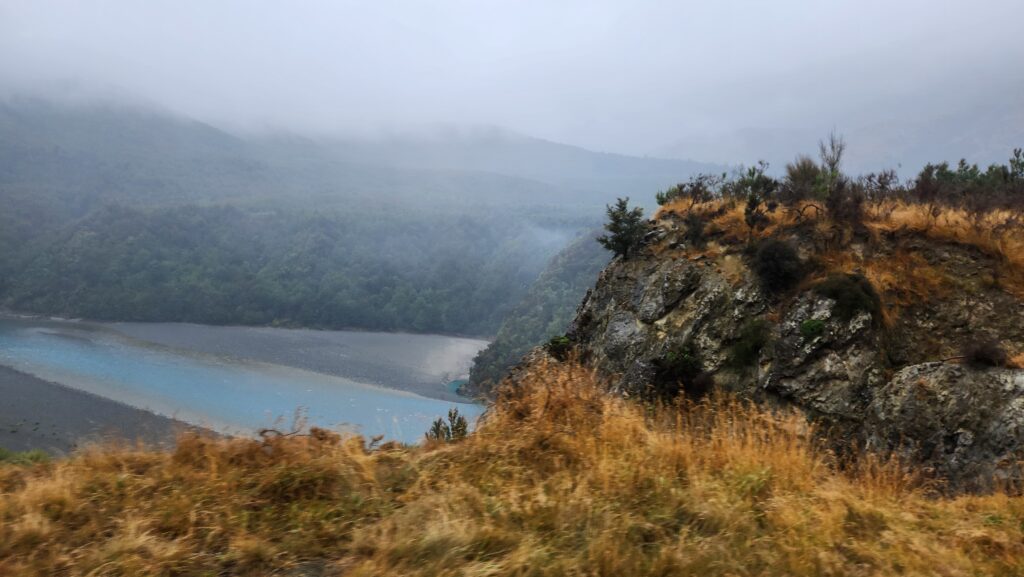
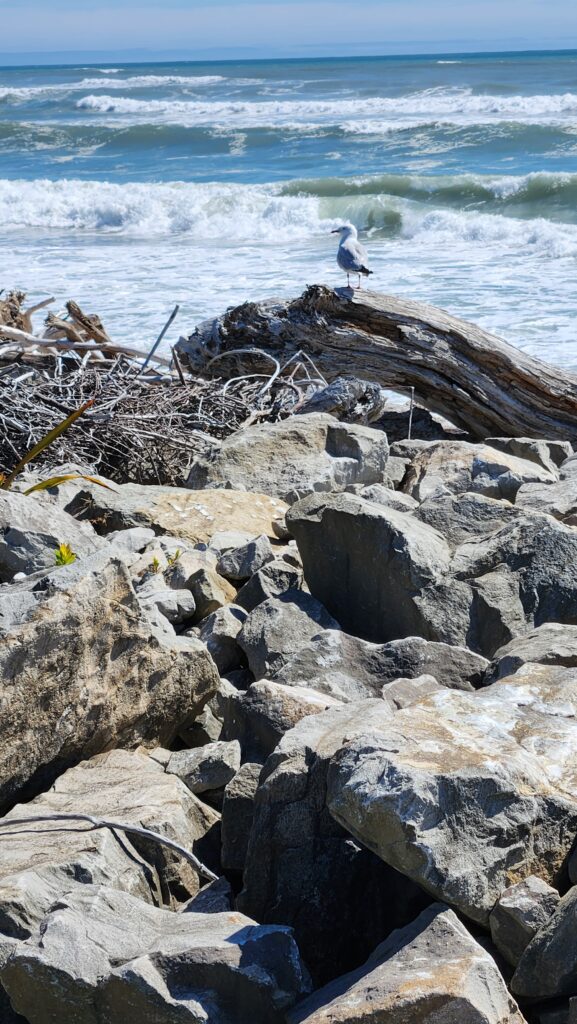

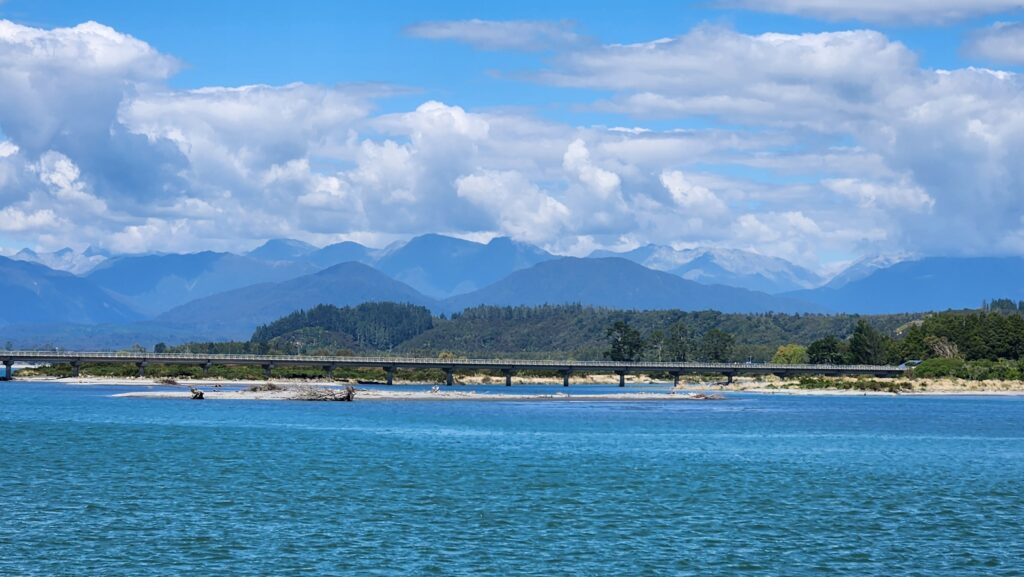
Day 10 – Travel Day

Since this is a travel day and we did not have any new adventures to share, I’m sharing some favorite pics from the trip so far that did not make it into my daily update! The picture to the left is our digs for one night in Christchurch. Up early tomorrow for the Tranzalpine train to Greymouth.
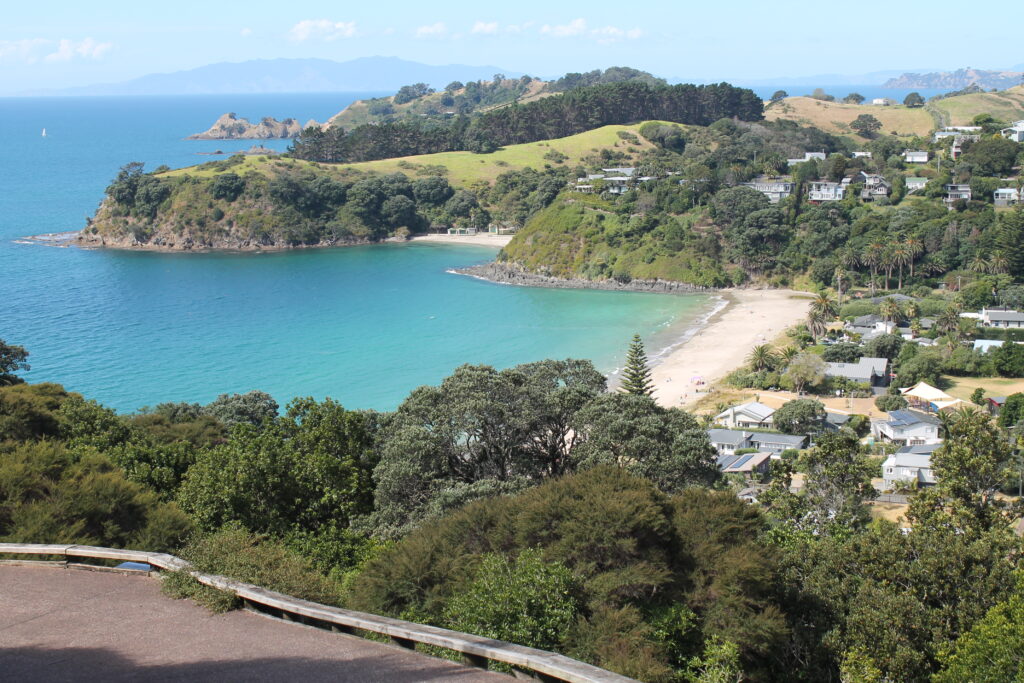
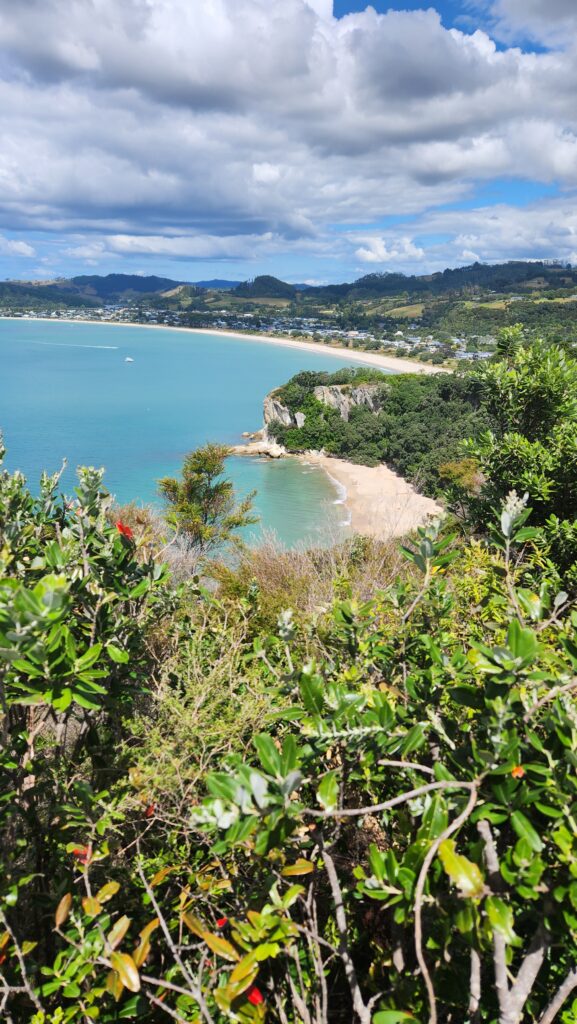
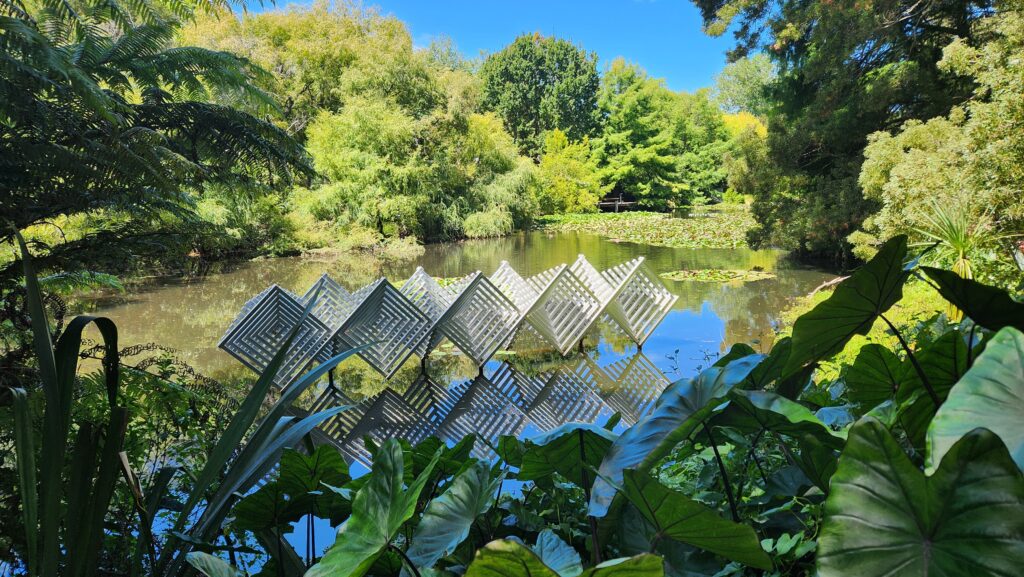

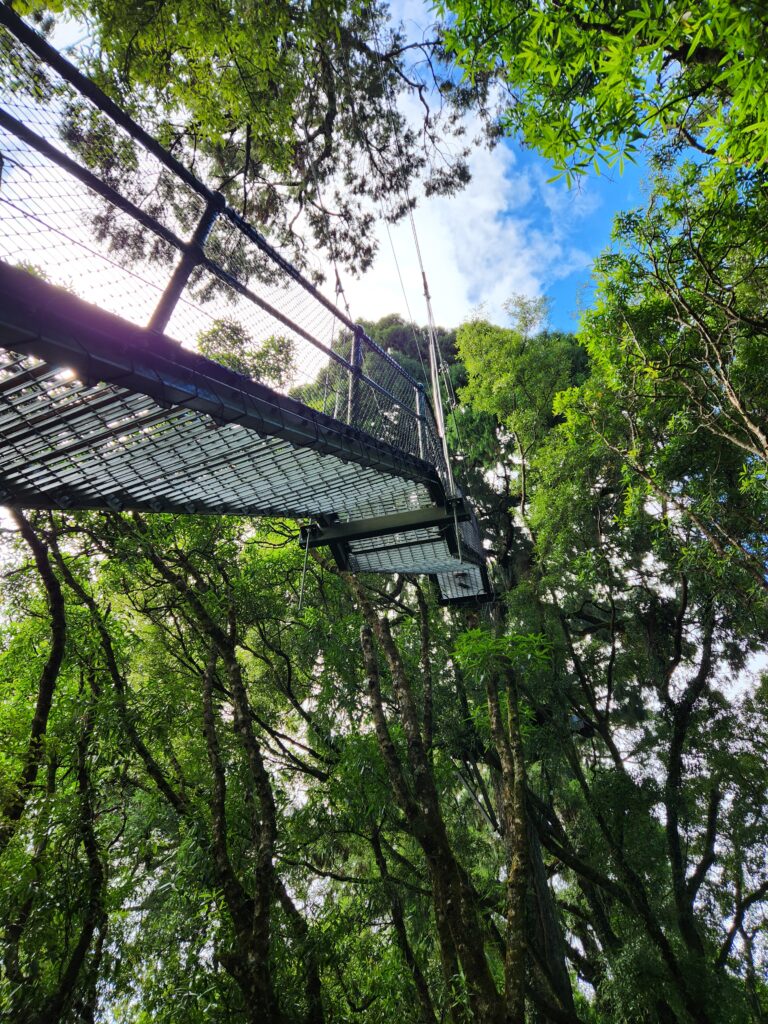

Day 9 – Orakei Korako
We visited a geothermal park in the Taupo Volcanic zone. After taking a ferry across the Waikato River we then were able to follow a boardwalk throughout the park that connected the various geysers, hot springs and mud pools. The board walk was created because the water that is running from the various geothermal phenomenon is very hot and dangerous to walk around. It is estimated that roughly 20 million liters of water flow into the river each day. Lake Taupo itself is a volcano crater that is surrounded by other, smaller volcanoes and these geothermal areas exist between the Taupo and Rotorua areas. Earlier in the morning we enjoyed walking around the lodge where we are staying. They have fantastic gardens that include vegetables and herbs as well as flowers and even a koi pond.


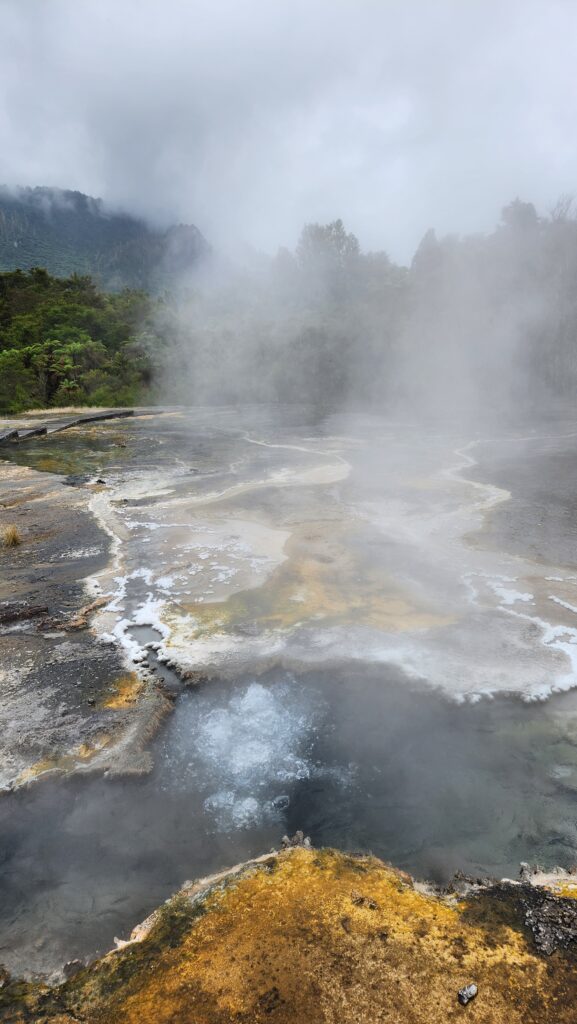
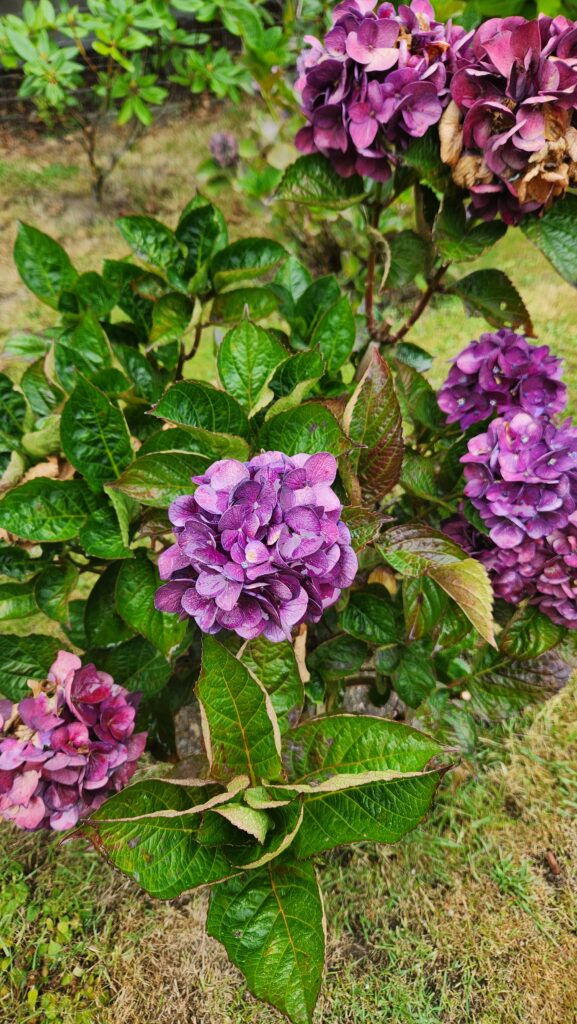
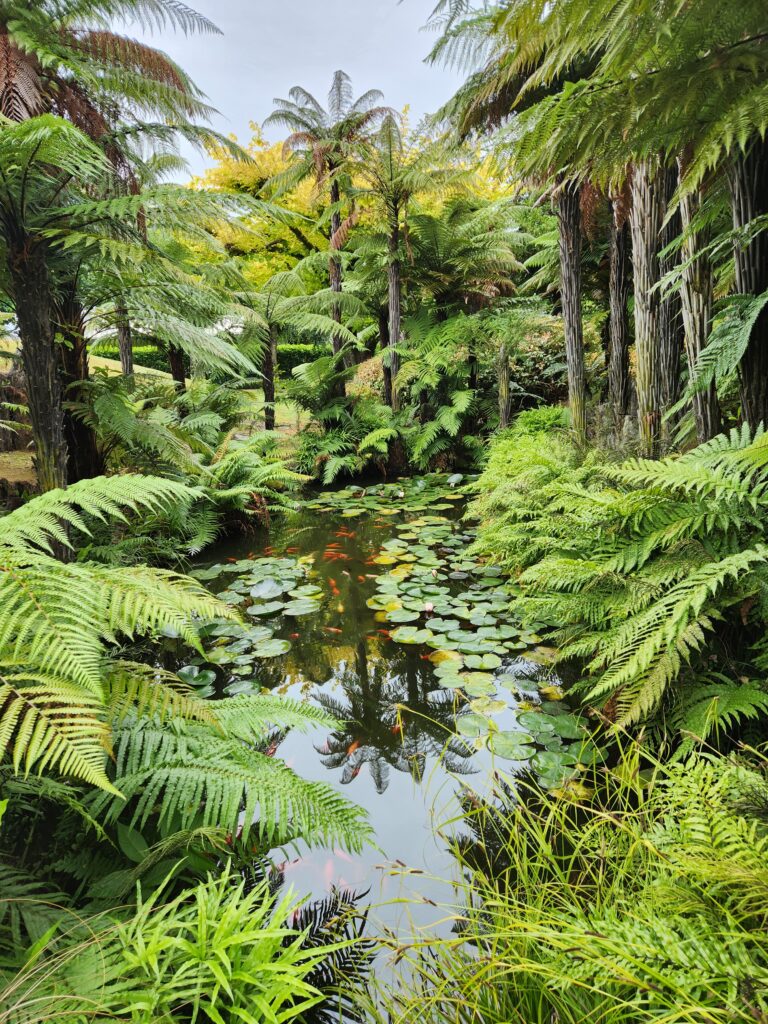
Day 8 – Lake Taupo Huka Falls

The Waikato River flows from the crater lake of Lake Taupo all the way to the Tasman sea. The river is the longest in New Zealand and because of the geography of the river it creates alot of energy as it narrows to flow over the volcanic canyon of the Huka Falls. As we hiked we could see the speed and power of the water flow of the river. This area is abundant in geothermal phenomenon. The area we visited contained hot springs that fed into the Waikato River.

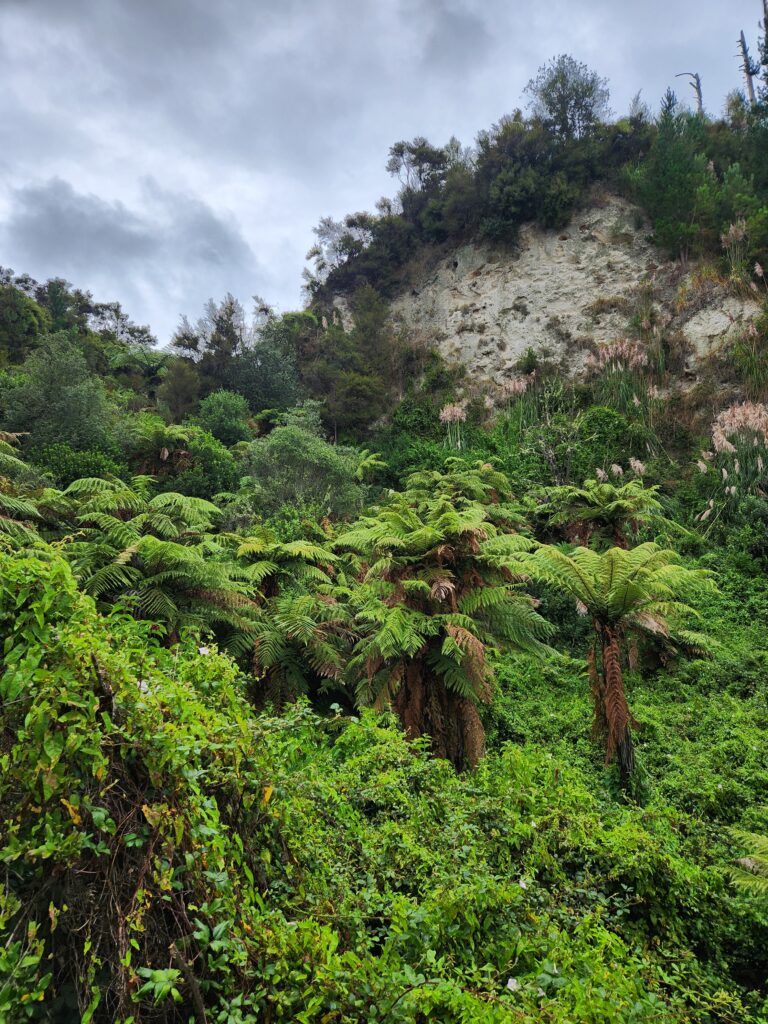
Day 7 – Ziplining and Lake Taupo
The ziplines we enjoyed have been set up in a conservation area where efforts are underway to restore the indigenous trees and forest that have been affected by invasive animal species like possums and rats. Originally New Zealand’s wildlife was mostly bird species, as people settled the island nation other species were brought and have endangered the birds and the forests. The zipline tour operator we were with today have been trapping and removing the invasive animals in this forest in an effort to revitalize the birds and the forest. After a morning of flying through the trees, we set off south to Lake Taupo. Our accommodation, Lake Taupo Lodge, has beautiful gardens and spectacular views of the lake. For dinner we enjoyed the dining and shopping district of the town of Taupo.

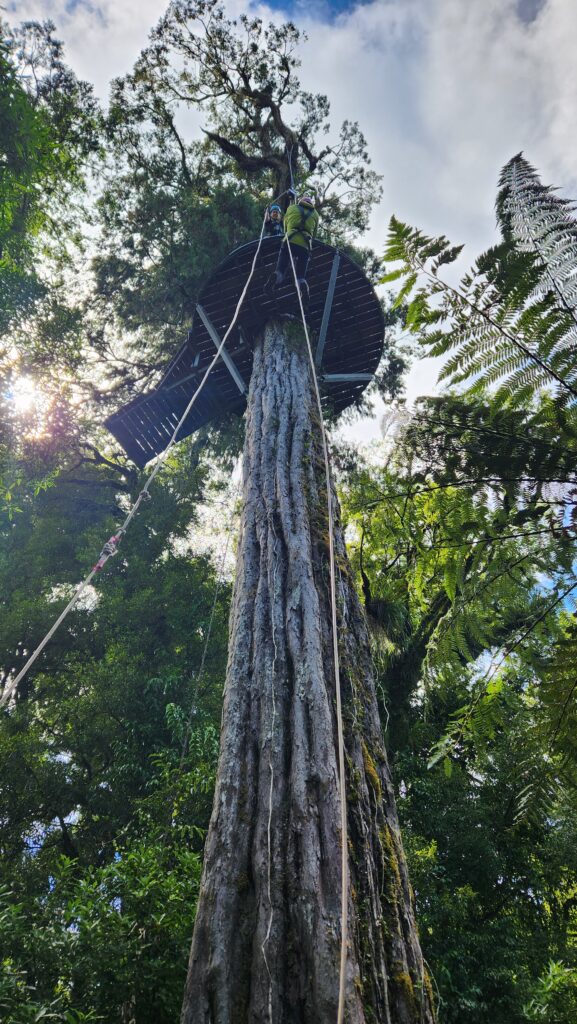
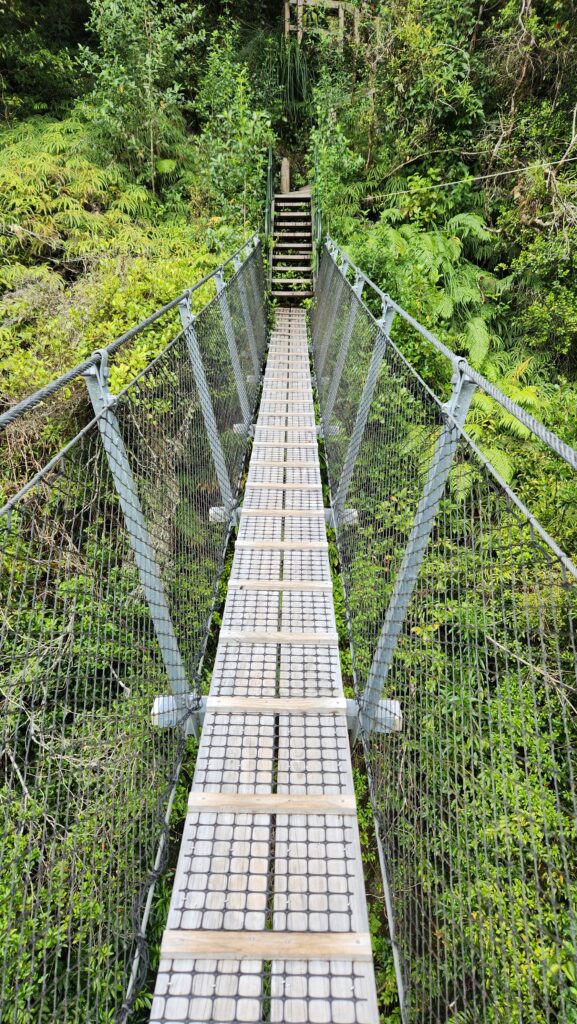


Day 6 – Kayaking on the Waikato River
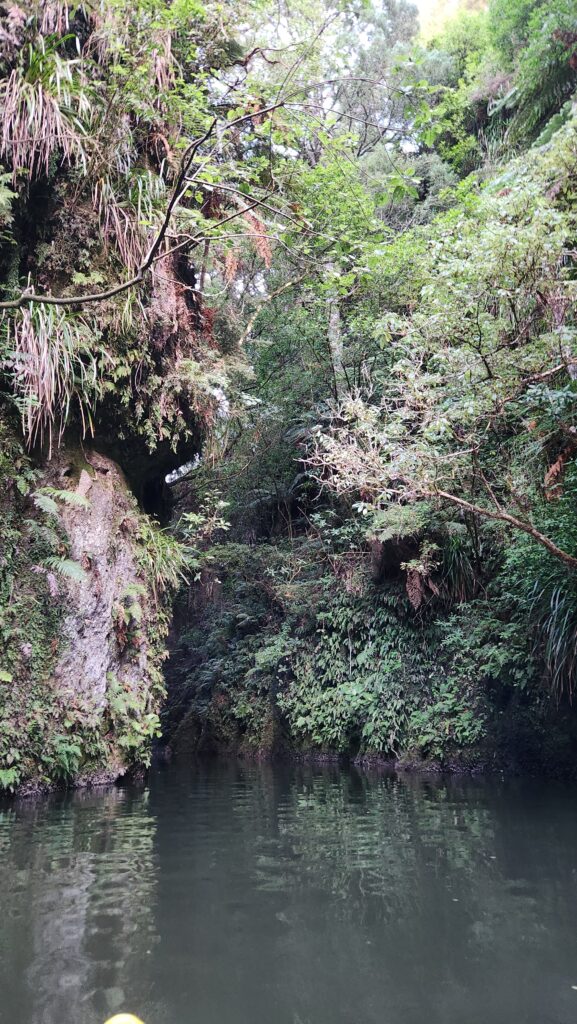
This evening we took a tour that had us kayaking down the Waikato River and onto an adjoining canyon. After sunset, floating by on our kayaks through the canyon we could see the glow worms light up all along the canyon walls. The worms are actually a type of fly in its larvae stage. The glow is caused by a chemical reaction in their digestive track that emits a blue-green glow. Once the bug emerges from the larvae stage as an adult fly, it will live only 24-48 hours. The Waikato is a river that is fed from Lake Taupo a crater lake created after one of the largest volcanic eruptions in the last 5,000 years. Lake Taupo is large enough that it is visible from space. The Waikato flows out to the Tasman sea.
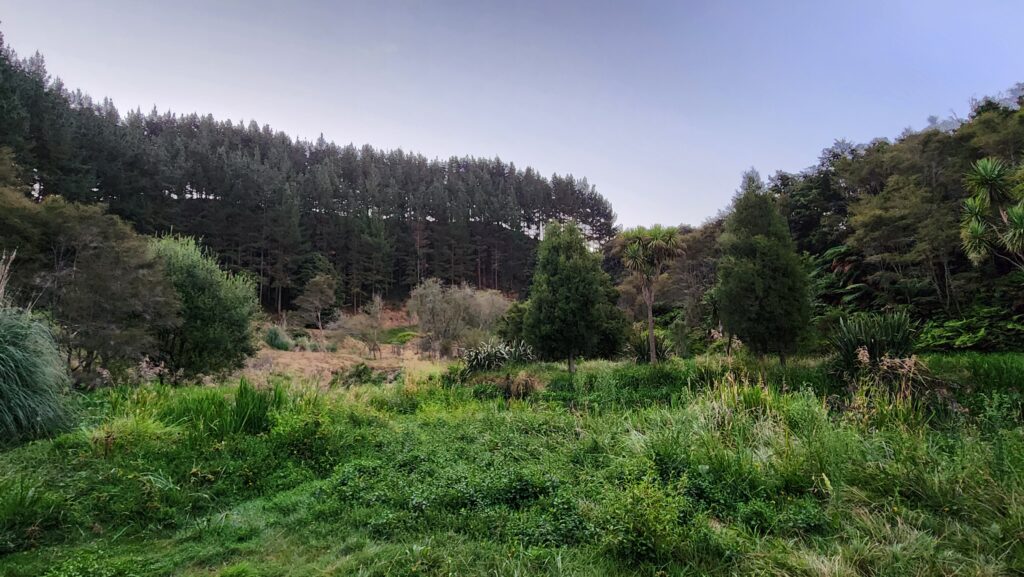
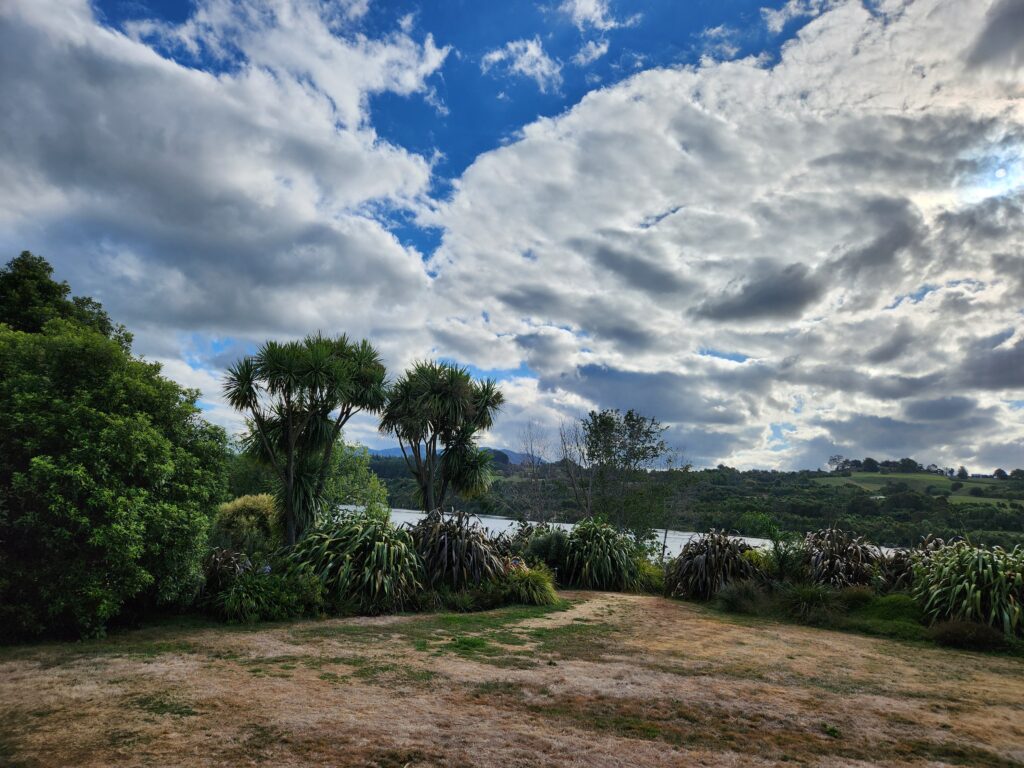
Day 5 – Hobbiton to Rotorua
Hobbiton is one of the most visited attractions in New Zealand. The attraction is basically the movie set for the Lord of the Rings and Hobbit movie series. Hobbiton is the land of the small hobbits. The site was scouted for the movie because it depicted the setting described in the Lord of the Rings books; there was a high hill for Bilbo Baggins house, a large tree for the site of the community parties, and a large lake by that tree. All surrounded by rolling hills. After filming the original movies from 2001 to 2003, the set was mostly torn down. However many fans would visit the area to see where the films were made. After the sets were reconstructed in 2012 for the Hobbit movie, the creator decided that leaving the sets and operating tours of the area would be a good idea. Since then the sets have been maintained and even added to for the Hobbiton tour of the movie set. As we toured the land of the hobbits the weather threatened rain most of the day, but held off until we reached our next destination in Rotorua. We then got cold wind with rain. We did manage to stop down by the lake to get some views before ending our day.
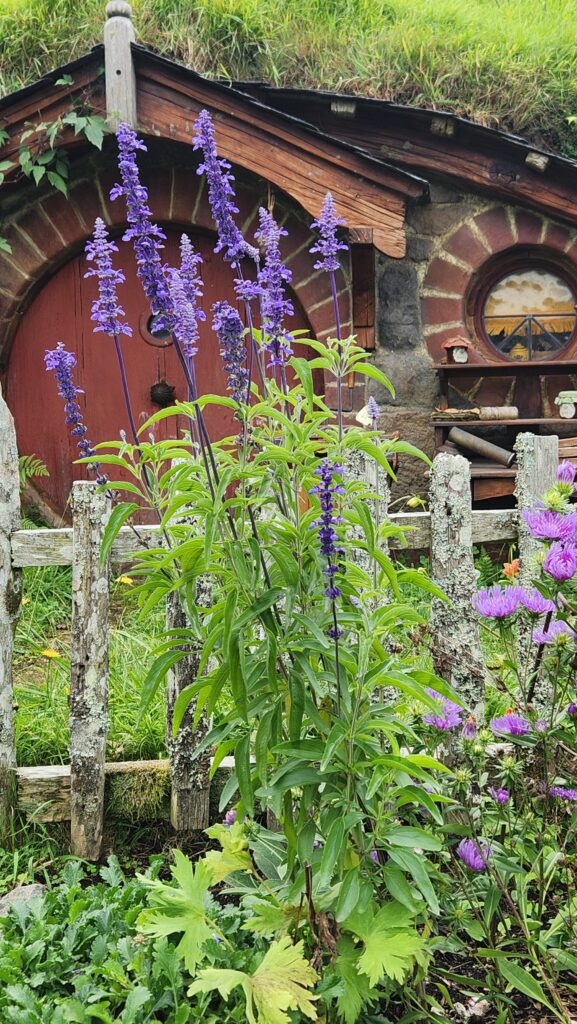
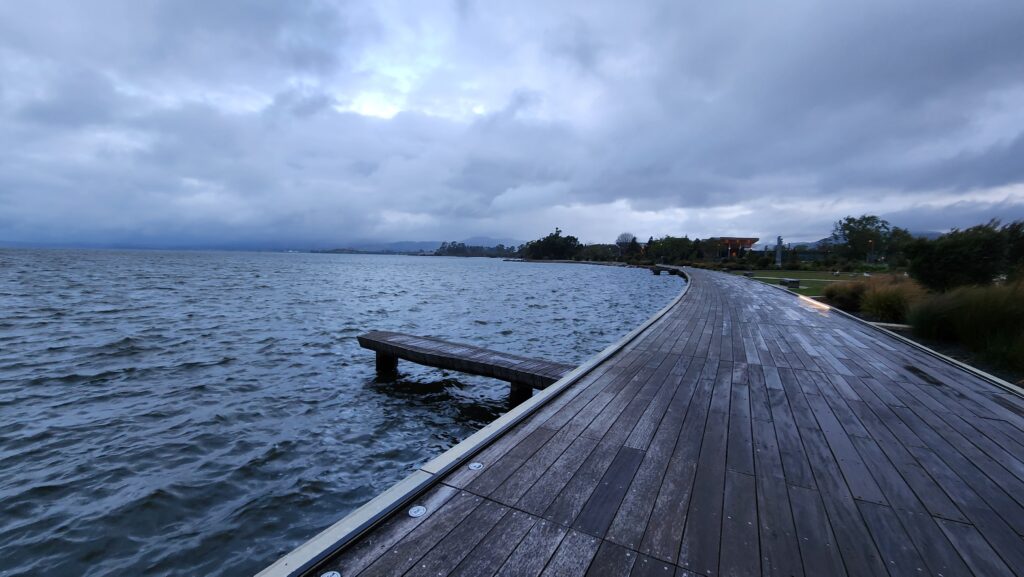

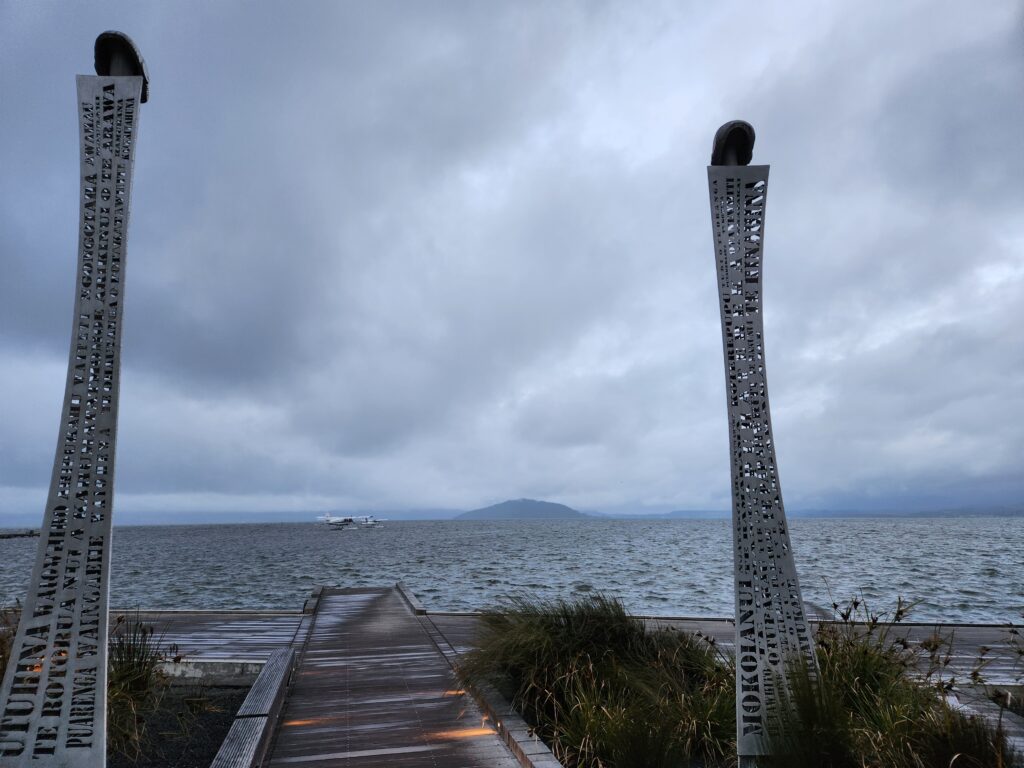
Day 4 – Matakana

The Kauri tree is indigenous to New Zealand. It is a tree that has a life span over a thousand years and grows quite large, producing durable wood. Settlers to New Zealand realized the potential for exporting the wood as well as the sap that the wood produces. This industry attracted many immigrants from Eastern Europe and when they settled here to log the trees and mine the sap from the Kauri tree, they brought with them grapes. Grapes that could be grown and turned into wine. This is when the wine industry was first introduced to New Zealand. While mostly white wines, Sauvignon Blanc and Pinot Gris, are seen imported to the US other grapes are being currently introduced to New Zealand. As climates change, the growing conditions for red varietals are becoming more available in New Zealand. Today we tasted wines from a boutique winery that produces Dolcetto and Sangiovese grapes. We also enjoyed lunch at a winery that also houses a sculpture garden. We visited a chocolate shop and a Manuka honey producer to round out the afternoon. In the evening for our last night in Auckland we visited the Ponsonby Road area for dinner, a cute dining and shopping district in Auckland.


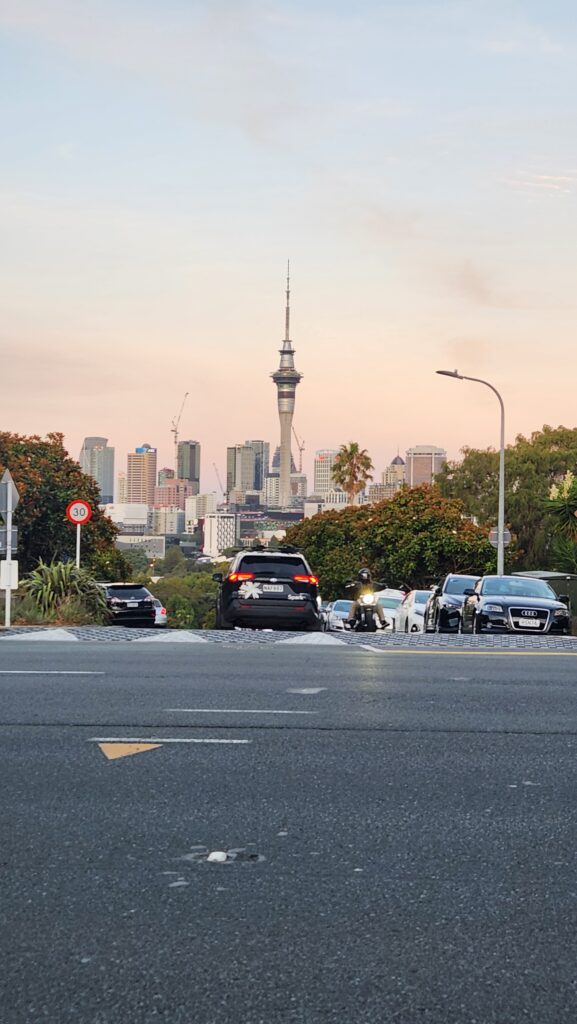
Day 3 – Coromandel Peninsula
The peninsula is to the east of Auckland about two hours away. Once on the peninsula we began the day with a hike to a lookout point above the town of Tairua. The morning was actually drizzly rain and very misty, but the view was still beautiful. From there we made our way to Hot Water Beach. This site was unbelievable. Hot springs are below the sand and at low tide you can dig a hole and get hot water. In the picture to the right, the rings in the water are actually from the water boiling. Don’t worry, when the water got too hot for us, we hopped up and jumped into the cool ocean water. From here we went to see Cathedral Cove, a well known rock formation on the beach. We were unable to get close because a cyclone that hit the area last year destroyed the stairs that led to the beach where this rock formation is. The scenery all day was absolutely beautiful and dramatic. We also learned a little more about New Zealand and its history. The Coromandel region is an important part of the history of New Zealand. Long before European settlers landed there, a polynesian people from islands east of New Zealand arrived in the Coromandel Peninsula. At the time the stars, path of the sun, and migratory patterns of birds were the only tools to navigate to this new land. Once here these people named their new land Aotearoa, land of the long white cloud. This began the long history of the Maori people. There is an effort today to revert the name of New Zealand to its original native name.
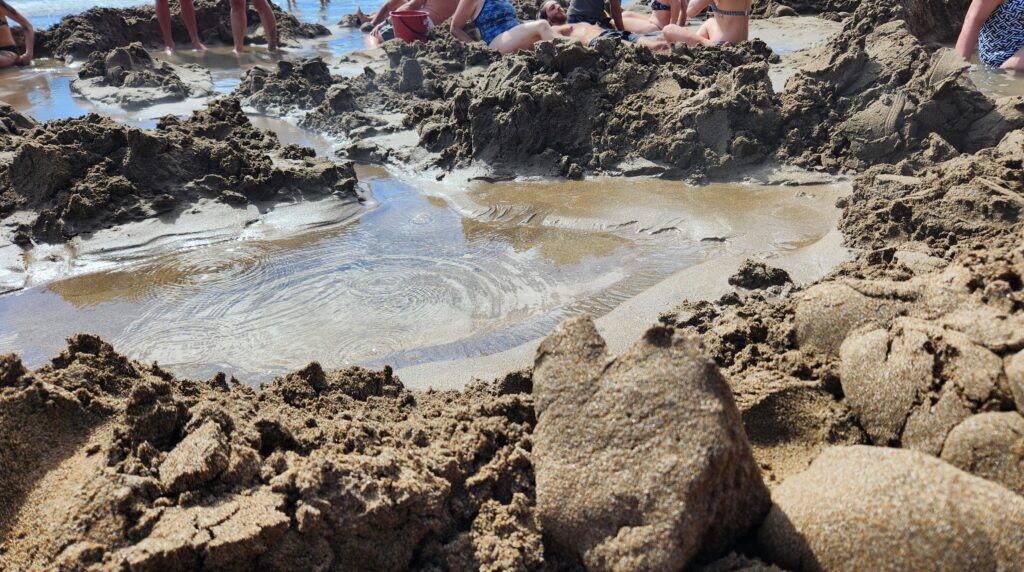

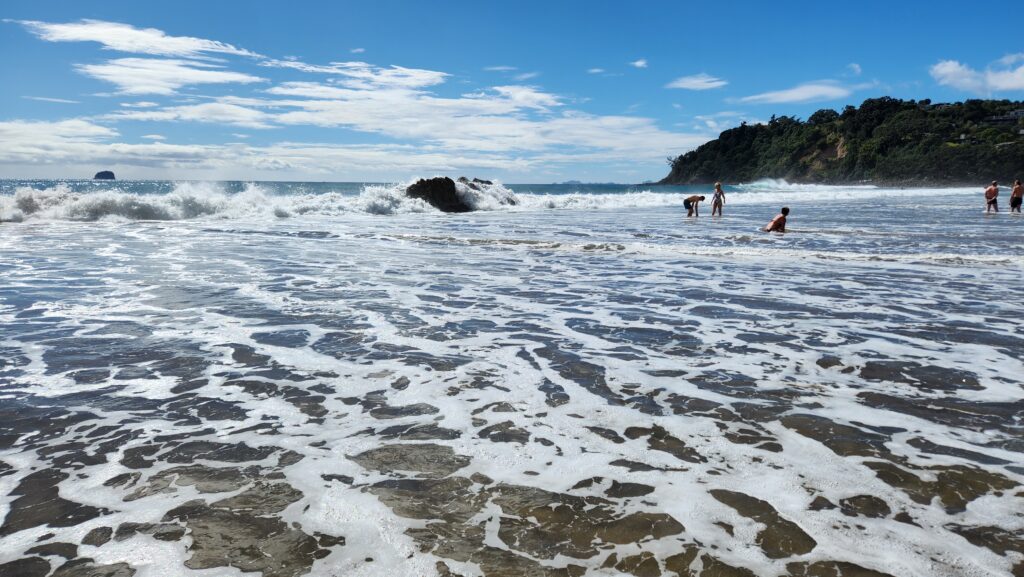
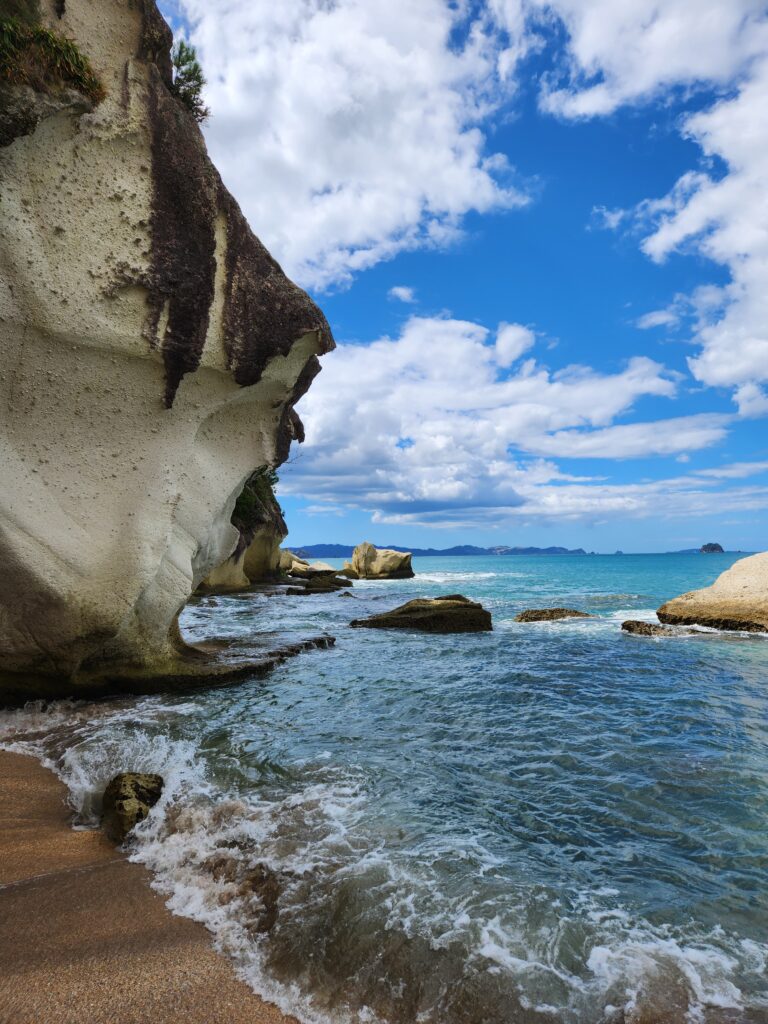
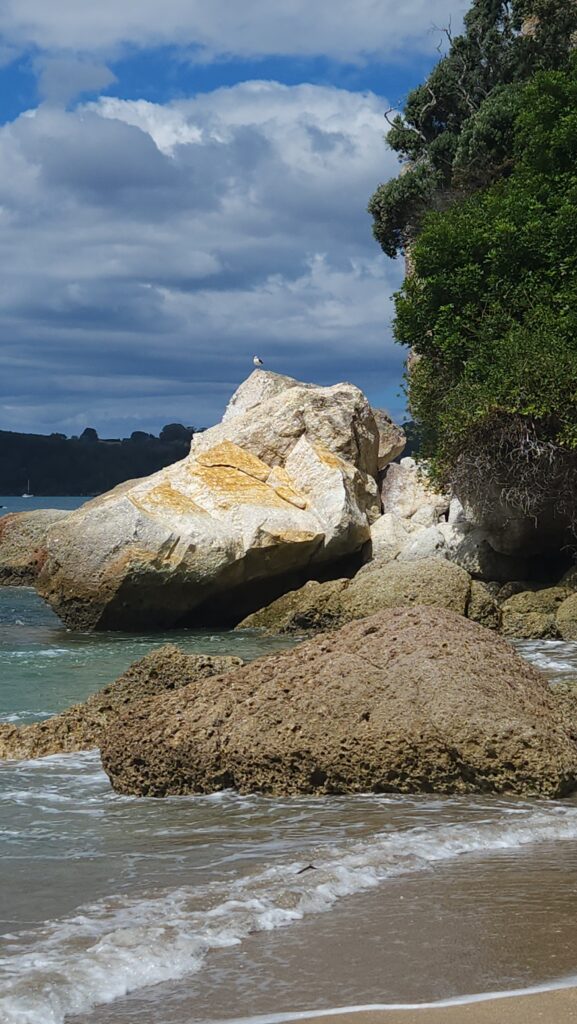
Day 2 – Waiheke Island
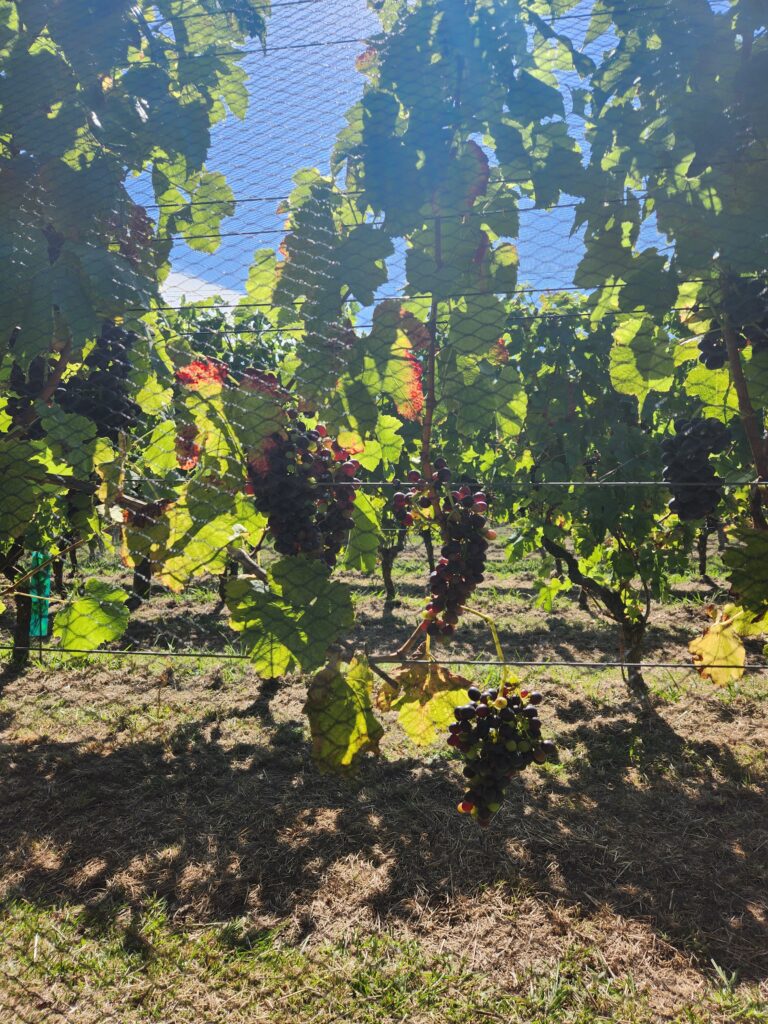
Today we took a ferry from Auckland to Waiheke Island where we met up with a small group tour. The tour took us to three boutique vineyards on the island. The first vineyard, Jurassic Ridge, was run by a husband and wife. They actually hand pick the grapes themselves and use a slow, natural method of wine production. Jurassic refers to the island itself being a large jurassic era piece of rock, instead of volcanic matter that is typical of islands. We then visited the Passage Rock vineyard, which was a little bit larger, but still a small operation. It had a beautiful tasting area. The last vineyard we stopped at was called Obsidion toward the north part of the island. All the wines were very good. The island has become known for its bordeaux style reds due to a layer of ash that settled on the island after a neighboring volcano erupted some time ago. The island is beautiful with rocky coasts and sandy beaches, rich greens and deep blues across the landscape. According to our guide the island has been growing recently in popularity, which is not surprising having been there to see how lovely it is and still relatively close to Auckland.
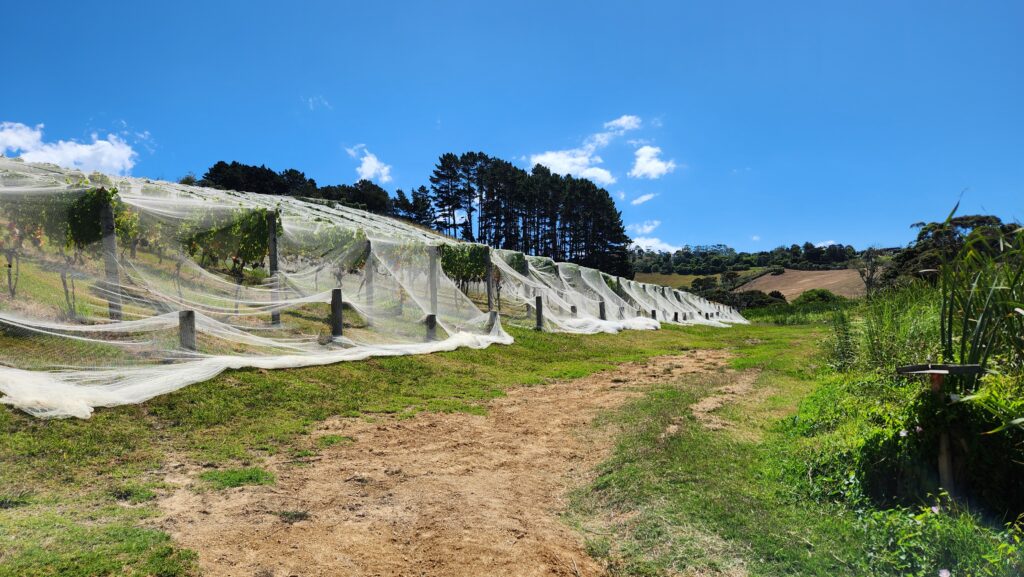


Day 1 – Auckland
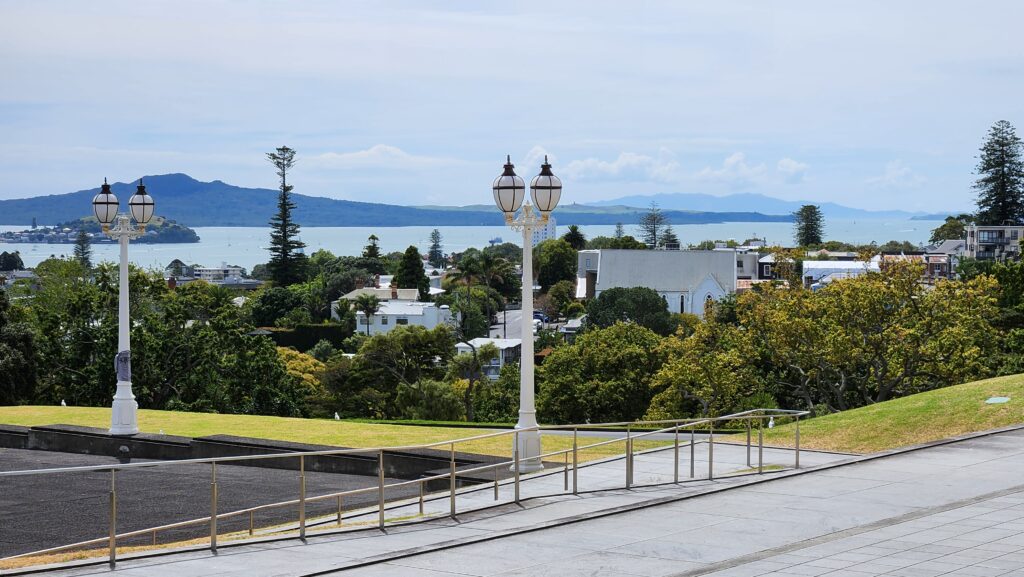
After spending many hours on airplanes and in airport lounges we made it to Auckland. We eased into the first day by leisurely walking around the city. We found Auckland Domain, a rather large park in the city. The walk to the park had us navigating through a couple of local universities, Auckland University of Technology and Auckland University. The park itself had trails throughout and was set on a hill. At the top of the hill was a stately building where there was a war memorial museum. We walked through botanical gardens with beautiful flowers and a fernery. We came across a sports complex that referred to the Auckland Bowling Club. We were very curious about a bowling club with outdoor fields. With a little google research we found that bowling is actually a game similar to bocce ball. For the evening we took a sailboat cruise from the marina. We enjoyed beautiful views of the city and surrounding islands. It was a little cloudy as we left the marina, but with a little patience, the clouds mixed for a pretty sunset. Back in our hotel, we have a wonderful view of the Auckland Skytower.
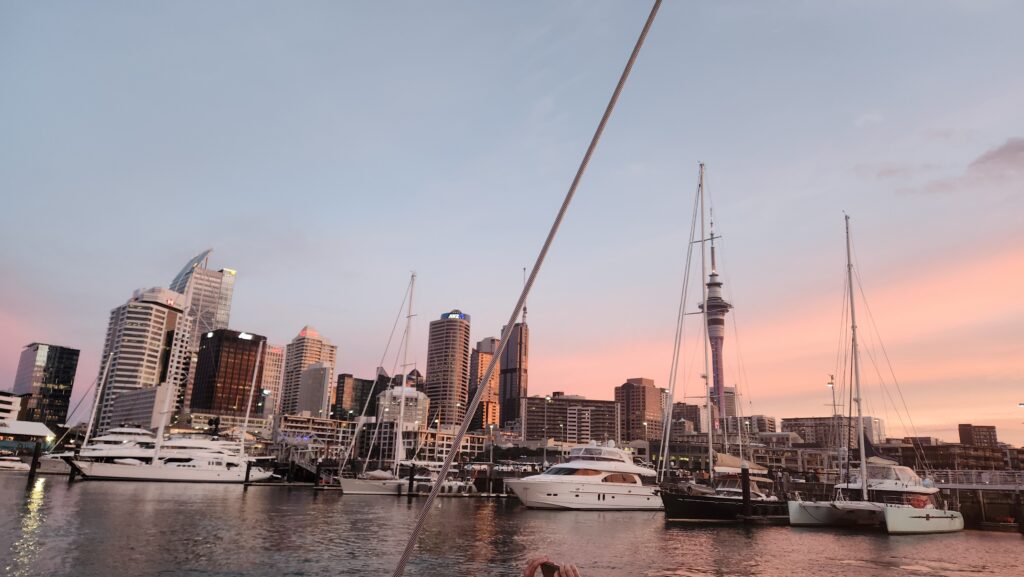

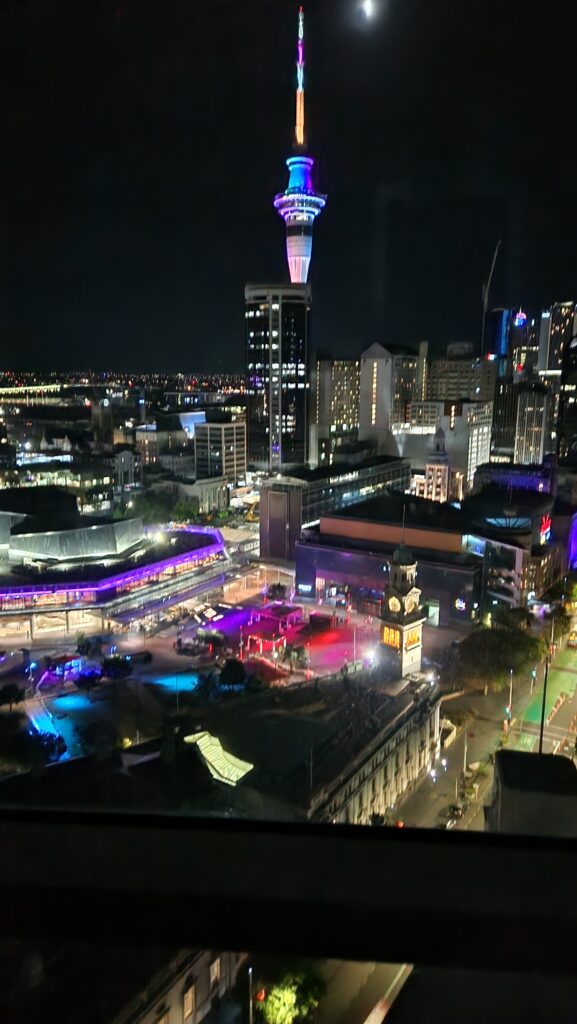
Day 0 – Marina Del Rey
While stopping in LA we visited the Academy Museum of Motion Pictures. Very interesting museum especially if you enjoy watching movies. The museum has displays that explain each of the elements of making a movie from the producer to the casting director, script writing, special effects and many more. Each display gives examples of that element and shows the results with movie clips of award winning movies we all know and love. One display went through the process of creating the sound for a scene from Indiana Jones. It showed how each level of sound is created from capturing the actors dialogue to adding in prop handling, footsteps, and music. Another display gave examples of the Mario Puzo book, The Godfather, being transformed into The Godfather movie script. In another installation, different Oscar awards through the ages were on display. Amazingly the design for the Oscar award has remained the same since the first one given in 1929. The installation also projected clips of famous Academy Award acceptance speeches from throughout of the years.


